
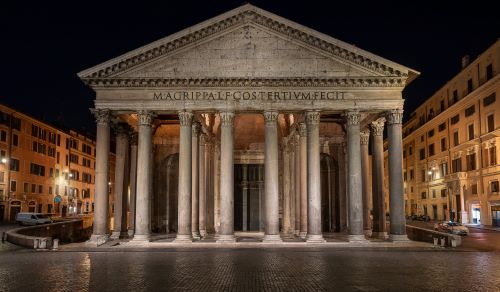
The Romans were a warrior people from very early on.
By Dr. Christopher Brooks
Professor of History
Portland Community College
Introduction
In many ways, Rome defines Western Civilization. Even more so than Greece, the Roman Republic and the Roman Empire that followed created the idea of a single, united civilization sharing certain attributes and providing a lasting intellectual and political legacy. Its boundaries, from what is today England to Turkey and from Germany to Spain, mark out the heartland of what its inhabitants would later consider itself to be “The West” in so many words. The Greek intellectual legacy was eagerly taken up by the Romans and combined with unprecedented organization and engineering on a scale the Greeks had never imagined, even under Alexander the Great.
Roman Origins
Rome was originally a town built amidst seven hills surrounded by swamps in central Italy. The Romans were just one group of “Latins,” central Italians who spoke closely-related dialects of the Latin language. Rome itself had a few key geographical advantages. Its hills were easily defensible, making it difficult for invaders to carry out a successful attack. It was at the intersection of trade routes, thanks in part to its proximity to a natural ford (a shallow part of a river that can be crossed on foot) in the Tiber River, leading to a prosperous commercial and mercantile sector that provided the wealth for early expansion. It also lay on the route between the Greek colonies of southern Italy and various Italian cultures in the central and northern part of the peninsula.
The legend that the Romans themselves invented about their own origins had to do with two brothers: Romulus and Remus. In the legend of Romulus and Remus, two boys were born to a Latin king, but then kidnapped and thrown into the Tiber River by the king’s jealous brother. They were discovered by a female wolf and suckled by her, eventually growing up and exacting their revenge on their treacherous uncle. They then fought each other, with Romulus killing Remus and founding the city of Rome. According to the story, the city of Rome was founded on April 21, 753 BCE. This legend is just that: a legend. Its importance is that it speaks to how the Romans wanted to see themselves, as the descendants of a great man who seized his birthright through force and power, accepting no equals. In a sense, the Romans were proud to believe that their ancient heritage involved being literally raised by wolves.
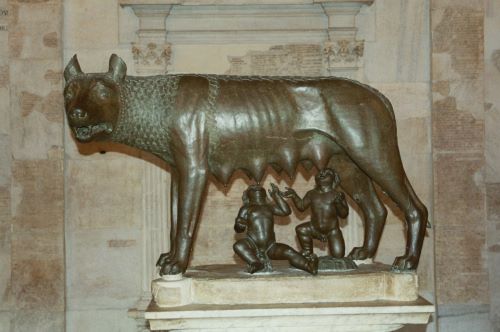
The Romans were a warrior people from very early on, feuding and fighting with their neighbors and with raiders from the north. They were allied with and, for a time, ruled by a neighboring people called the Etruscans who lived to the northwest of Rome. The Etruscans were active trading partners with the Greek poleis of the south, and Rome became a key link along the Etruscan – Greek trade route. The Etruscans ruled a loose empire of allied city-states that carried on a brisk trade with the Greeks, trading Italian iron for various luxury goods. This mixing of cultures, Etruscan, Greek, and Latin, included shared mythologies and stories. The Greek gods and myths were shared by the Romans, with only the names of the gods being changed (e.g. Zeus became Jupiter, Aphrodite became Venus, Hades became Pluto, etc.). In this way, the Romans became part of the larger Mediterranean world of which the Greeks were such a significant part.
According to Roman legends, the Etruscans ruled the Romans from some time in the eighth century BCE until 509 BCE. During that time, the Etruscans organized them to fight along Greek lines as a phalanx. From the phalanx, the Romans would eventually create new forms of military organization and tactics that would overwhelm the Greeks themselves (albeit hundreds of years later). There is no actual evidence that the Etruscans ruled Rome, but as with the legend of Romulus and Remus, the story of early Etruscan rule inspired the Romans to think of themselves in certain ways – most obviously in utterly rejecting foreign rule of any kind, and even of foreign cultural influence. Romans were always fiercely proud (to the point of belligerence) of their heritage and identity.
By 600 BCE the Romans had drained the swamp in the middle of their territory and built the first of their large public buildings. As noted, they were a monarchy at the time, ruled by (possibly) Etruscan kings, but with powerful Romans serving as advisers in an elected senate. Native-born men rich enough to afford weapons were allowed to vote, while native-born men who were poor were considered full Romans but had no vote. In 509 BCE (according to their own legends), the Romans overthrew the last Etruscan king and established a full Republican form of government, with elected senators making all of the important political decisions. Roman antipathy to kings was so great that no Roman leader would ever call himself Rex – king – even after the Republic was eventually overthrown centuries later.
Note: The Celts
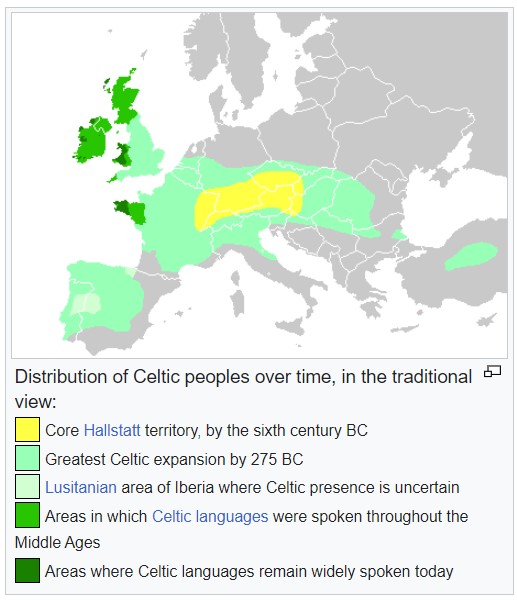
While the Hellenistic world was flourishing in Greece and the Middle East, and Rome was beginning its long climb from obscurity to power, most of Western Europe was dominated by the Celts. The Celts provide background context to the rise of Rome, since Roman expansion would eventually spell the end of Celtic independence in most of Europe.
Much less is known about the Celts than about the contemporaneous cultures of the Mediterranean because the Celts did not leave a written record. The Celts were not a unified empire of any kind; they were a tribal people who shared a common culture and a set of beliefs, along with certain technologies having to do with metal-working and agriculture.
The Celts were a warrior society which seemed to have practiced a variation of what would later be known as feudal law, in which every offense demanded retribution in the former of either violence or “man gold”: the payment needed to atone for a crime and thereby prevent the escalation of violence. The Celts were in contact with the people of the Mediterranean world from as early as 800 BCE, mostly through trade. They lived in fortified towns and were as quick to raid as to trade with their neighbors.
By about 450 BCE the Celts expanded dramatically across Europe. They seem to have become more warlike and expansionist and they adopted a number of technologies already in use further south, including chariot warfare and currency. By 400 BCE groups of Celts began to raid further into “civilized” lands, sacking Rome itself in 387 BCE and pushing into the Hellenistic lands of Macedonia, Greece, and Anatolia. Subsequently, Celtic raiders tended to settle by about 200 BCE, often forming distinct smaller kingdoms within larger lands, such as the region called Galatia in Anatolia, and serving as mercenary warriors for the Hellenistic kingdoms.
Eventually, when the Romans began to expand beyond Italy itself, it was the Celts who were first conquered and then assimilated into the Republic. The Romans regarded Celts as barbarians, but they were thought to be barbarians who were at least capable of assimilating and adopting “true” civilization from the Romans. Centuries later, the descendants of conquered Celts considered themselves fully Roman: speaking Latin as their native language, wearing togas, drinking wine, and serving in the Roman armies.
The Republic
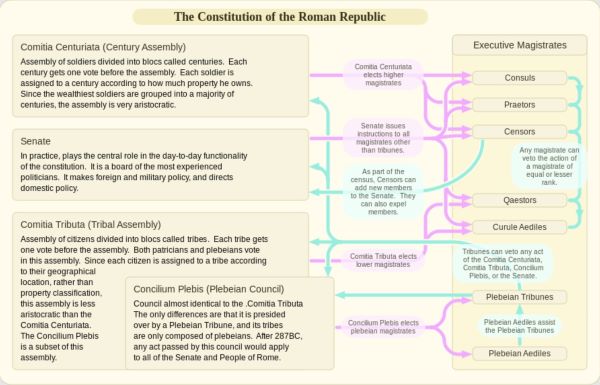
The Roman Republic had a fairly complex system of government and representation, but it was one that would last about 500 years and preside over the vast expansion of Roman power. An assembly, called the Centuriate Assembly, was elected by the citizens and created laws. Each year, the assembly elected two executives called consuls to oversee the laws and ensure their enforcement. The consuls had almost unlimited power, known as imperium, including the right to inflict the death penalty on law-breakers, and they were preceded everywhere by twelve bodyguards called lictors. Consular authority was, however, limited by the fact that the terms were only a year long and each consul was expected to hold the other in check if necessary. Under the consuls there was the Senate, essentially a large body of aristocratic administrators, appointed for life, who controlled state finances. The whole system was tied closely to the priesthoods of the Roman gods, who performed divinations and blessings on behalf of the city. While the Romans were deeply suspicious of individuals who seemed to be trying to take power themselves, several influential families worked behind the scenes to ensure that they could control voting blocks in the Centuriate Assembly and the Senate.
When Rome faced a major crisis, the Centuriate Assembly could vote to appoint a dictator, a single man vested with the full power of imperium. Symbolically, all twenty-four of the lictors would accompany the dictator, who was supposed to use his almost-unlimited power to save Rome from whatever threatened it, then step down and return things to normal. While the office of dictator could have easily led to an attempted takeover, for hundreds of years very few dictators abused their powers and instead respected the temporary nature of Roman dictatorship itself.
The rich were referred to as patricians, families with ancient roots in Rome who occupied most of the positions of the senate and the judiciary in the city. There were about one hundred patrician families, descending from the men Romulus had, allegedly, appointed to the first senate. They were allied with other rich and powerful people, owners of large tracts of land, in trying to hold in check the plebeians, Roman citizens not from patrician backgrounds.
While the Senate began as an advisory body, it later wrested real law-making power from the consuls (who were, after all, almost always drawn from its members). By 133 BCE, the Senate proposed legislation and could veto the legislation of the consuls. An even more important power was its ability to designate funds for war and public building, giving it enormous power over what the Roman government actually did, since the senate could simply cut off funding to projects it disagreed with.The Centuriate Assembly was divided into five different classes based on wealth (a system that ensured that the wealthy could always outvote the poorer). The wealthiest class consisted of the equestrians, so named because they could afford horses and thus form the Roman cavalry; the equestrian class would go on to be a leading power bloc in Roman history well into the Imperial period. The Centuriate Assembly voted on the consuls each year, declared war and peace, and acted as a court of appeal in legal cases involving the death penalty. It could also propose legislation, but the Senate had to approve it for it to become law.
Class Struggle
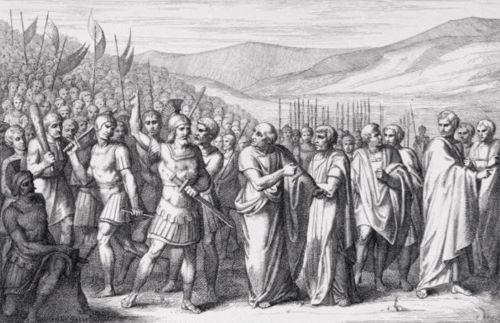
Rome struggled with a situation analogous to that of Athens, in which the rich not only had a virtual monopoly on political power, but in many cases had the legal right to either enslave or at least extract labor from debtors. In Rome’s case, an ongoing class struggle called the Conflict of Orders took place from about 500 BCE to 360 BCE (140 years!), in which the plebeians struggled to get more political representation. In 494 BCE, the plebeians threatened to simply leave Rome, rendering it almost defenseless, and the Senate responded by allowing the creation of two officials called Tribunes, men drawn from the plebeians who had the legal power to veto certain decisions made by the Senate and consuls. Later, the government created a Plebeian Council to represent the needs of the plebeians, approved the right to marry between patricians and plebeians, banned debt slavery, and finally, came to the agreement that of the two consuls elected each year, one had to be a plebeian. By 287 BCE, the Plebeian Assembly could pass legislation with the weight of law as well.
Roman soldiers were citizen-soldiers, farmers who volunteered to fight for Rome in hopes of being rewarded with wealth taken from defeated enemies. An important political breakthrough happened in about 350 BCE when the Romans enacted a law that limited the amount of land that could be given to a single citizen after a victory, ensuring a more equitable distribution of land to plebeian soldiers. This was a huge incentive to serve in the Roman army, since any soldier now had the potential to become very rich if he participated in a successful campaign against Rome’s enemies.
That being said, class struggle was always a factor in Roman politics. Even after the plebeians gained legal concessions, the rich always held the upper hand because wealthy plebeians would regularly join with patricians to out-vote poorer plebeians. Likewise, in the Centuriate Assembly, the richer classes had the legal right to out-vote the poorer classes – the equestrians and patricians often worked together against the demands of the poorer classes. Practically speaking, by the early third century BCE the plebeians had won meaningful legal rights, namely the right to representation and lawmaking, but those victories were often overshadowed by the fact that wealthy plebeians increasingly joined with the existing patricians to create something new: the Roman aristocracy. Most state offices did not pay salaries, so only those with substantial incomes from land (or from loot won in campaigns) could afford to serve as full-time representatives, officials, or judges – that, too, fed into the political power of the aristocracy over common citizens.
In the midst of this ongoing struggle, the Romans came up with the basis of Roman law, the system of law that, through various iterations, would become the basis for most systems of law still in use in Europe today (Britain being a notable exception). Private law governed disputes between individuals (e.g. property suits, disputes between business partners), while public law governed disputes between individuals and the government (e.g. violent crimes that were seen as a threat to the social order as a whole). In addition, the Romans established the Law of Nations to govern the territories it started to conquer in Italy; it was an early form of international law based on what were believed to be universal standards of justice.
The plebeians had been concerned that legal decisions would always favor the patricians, who had a monopoly on legal proceedings, so they insisted that the laws be written down and made publicly available. Thus, in 451 BCE, members of the Roman government wrote the Twelve Tables, lists of the laws available for everyone to see, which were then posted in the Roman Forum in the center of Rome. Just as it was done in Athens a hundred years earlier, having the laws publicly available reduced the chances of corruption. In fact, according to a Roman legend, the ten men who were charged with recording the laws were sent to Athens to study the laws of Solon of Athens; this was a deliberate use or “copy” of his idea.
Roman Expansion
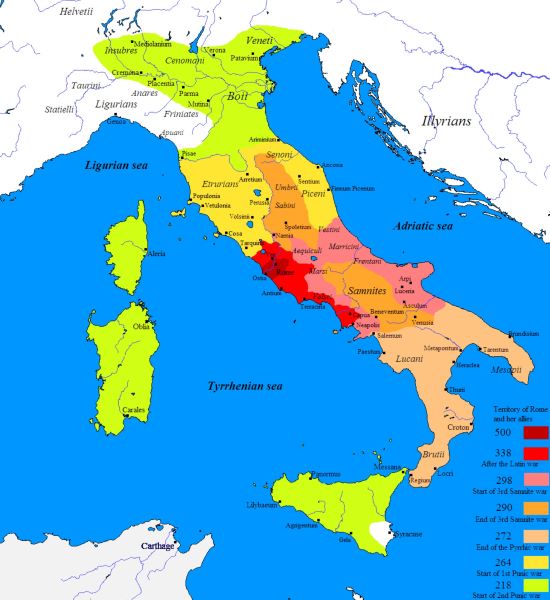
Roman expansion began with its leadership of a confederation of allied cities, the Latin League. Rome led this coalition against nearby hill tribes that had periodically raided the area, then against the Etruscans that had once ruled Rome itself. Just as the Romans started to consider further territorial expansion, a fierce raiding band of Celts swooped in and sacked Rome in 389 BCE, a setback that took several decades to recover from. In the aftermath, the Romans swore to never let the city fall victim to an attack again.
A key moment in the early period of Roman expansion was in 338 BCE when Rome defeated its erstwhile allies in the Latin League. Rome did not punish the cities after it defeated them, however. Instead, it offered them citizenship in its republic (albeit without voting rights) in return for pledges of loyalty and troops during wartime, a very important precedent because it meant that with every victory, Rome could potentially expand its military might. Soon, the elites of the Latin cities realized the benefits of playing along with the Romans. They were dealt into the wealth distributed after military victories and could play an active role in politics so long as they remained loyal, whereas resisters were eventually ground down and defeated with only their pride to show for it. While Rome would rarely extend actual citizenship to whole communities in the future, the assimilation of the Latins into the Roman state did set an important precedent: conquered peoples could be won over to Roman rule and contribute to Roman power, a key factor in Rome’s ongoing expansion from that point forward.
Rome rapidly expanded to encompass all of Italy except the southernmost regions. Those regions, populated largely by Greeks who had founded colonies there centuries before, invited a Greek warrior-king named Pyrrhus to aid them against the Romans around 280 BCE (Pyrrhus was a Hellenistic king who had already wrested control of a good-sized swath of Greece from the Antigonid dynasty back in Greece). Pyrrhus won two major battles against the Romans, but in the process he lost two-thirds of his troops. After his victories, he made a comment that “one more such victory will undo me” – this led to the phrase “pyrrhic victory,” which means a temporary victory that ultimately spells defeat, or winning the battle but losing the war. He took his remaining troops and returned to Greece. After he fled, the south was unable to mount much of a resistance, and all of Italy was under Roman control by 263 BCE.
Roman Militarism
It is important to emphasize the extreme militarism and terrible brutality of Rome during the republican period, very much including this early phase in which it began to acquire its empire. Wars were annual: with very few exceptions over the centuries the Roman legions would march forth to conquer new territory every single year. The Romans swiftly acquired a reputation for absolute ruthlessness and even wanton cruelty, raping and/or slaughtering the civilian inhabitants of conquered cities, enslaving thousands, and in some cases utterly wiping out whole populations (the neighboring city of Veii was obliterated in roughly 393 BCE, for example, right at the start of the conquest period). The Greek historian Polybius calmly noted at the time in his sweeping history of the republic that insofar as there was a deliberate intention behind all of this cruelty, it was easy to identify: causing terror.
Roman soldiers were inspired by straightforward greed as well as the tremendous cultural importance placed on winning military glory. Nothing was as important to a male Roman citizen than his reputation as a soldier. Likewise, Roman aristocrats all acquired their political power through military glory until late in the republic, and even then military glory was all but required for a man to achieve any kind of political importance. The greatest honor a Roman could win was a triumph, a military parade displaying the spoils of war to the cheers of the people of Rome; many people held important positions in Rome, but only the greatest generals were ever rewarded with a triumph.
The overall picture of Roman culture is of a society that was in its own way as fanatical and obsessed with war as was Sparta during the height of its barracks society. Unlike Sparta, however, Rome was able to mobilize gigantic armies, partly because slaves came to perform most of the work on farms and workshops over time, freeing up free Roman men to participate in the annual invasions of neighboring territories. One prominent contemporary historian of Rome, W.V. Harris, wisely warns against the temptation of “power worship” when studying Roman history. Rome did indeed accomplish remarkable things, but it did so through appalling cruelty and astonishing levels of violence.
The Punic Wars
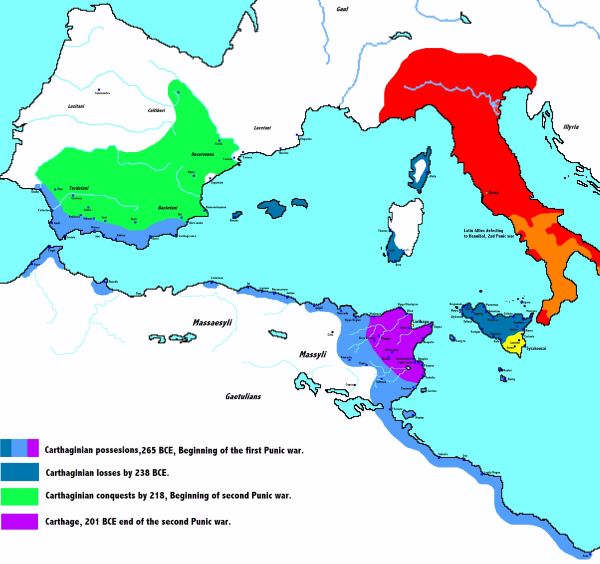
Rome’s great rival in this early period of expansion was the North-African city of Carthage, founded centuries earlier by Phoenician colonists. Carthage was one of the richest and most powerful trading empires of the Hellenistic Age, a peer of the Alexandrian empires to the east, trading with them and occasionally skirmishing with the Ptolemaic armies of Egypt and with the Greek cities of Sicily. Rome and Carthage had long been trading partners, and for centuries there was no real reason for them to be enemies since they were separated by the Mediterranean. That being said, as Rome’s power increased to encompass all of Italy, the Carthaginians became increasingly concerned that Rome might pose a threat to its own dominance.
Conflict finally broke out in 264 BCE in Sicily. The island of Sicily was one of the oldest and most important areas for Greek colonization. There, a war broke out between the two most powerful poleis, Syracuse and Messina. The Carthaginians sent a fleet to intervene on behalf of Messinans, but the Messinans then called for help from Rome as well (a betrayal of sorts from the perspective of Carthage). Soon, the conflict escalated as Carthage took the side of Syracuse and Rome saw an opportunity to expand Roman power in Sicily. The Centuriate Assembly voted to escalate the Roman military commitment since its members wanted the potential riches to be won in war. This initiated the First Punic War, which lasted from 264 to 241 BCE. (Note: “Punic” refers to the Roman term for Phoenician, and hence Carthage and its civilization.)
The Romans suffered several defeats, but they were rich and powerful enough at this point to persist in the war effort. Rome benefited greatly from the fact that the Carthaginians did not realize that the war could grow to be about more than just Sicily; even after winning victories there, the Carthaginians never tried to invade Italy itself (which they could have done, at least early on). The Romans eventually learned how to carry out effective naval warfare and stranded the Carthaginian army in Sicily. The Carthaginians sued for peace in 241 BCE and agreed to give up their claims to Sicily and to pay a war indemnity. The Romans, however, betrayed them and seized the islands of Corsica and Sardinia as well, territories that were still under the nominal control of Carthage.
From the aftermath of the First Punic War and the seizure of Sicily, Sardinia, and Corsica emerged the Roman provincial system: the islands were turned into “provinces” of the Republic, each of which was obligated to pay tribute (the “tithe,” meaning tenth, of all grain) and follow the orders of Roman governors appointed by the senate. That system would continue for the rest of the republican and imperial periods of Roman history, with the governors wielding enormous power and influence in their respective provinces.
Unsurprisingly, the Carthaginians wanted revenge, not just for their loss in the war but for Rome’s seizure of Corsica and Sardinia. For twenty years, the Carthaginians built up their forces and their resources, most notably by invading and conquering a large section of Spain, containing rich mines of gold and copper and thousands of Spanish Celts who came to serve as mercenaries in the Carthaginian armies. In 218 BCE, the great Carthaginian general Hannibal (son of the most successful general who had fought the Romans in the First Punic War) launched a surprise attack in Spain against Roman allies and then against Roman forces themselves. This led to the Second Punic War (218 BCE – 202 BCE).
Hannibal crossed the Alps into Italy from Spain with 60,000 men and a few dozen war elephants (most of the elephants perished, but the survivors proved very effective, and terrifying, against the Roman forces). For the next two years, he crushed every Roman army sent against him, killing tens of thousands of Roman soldiers and marching perilously close to Rome. Hannibal never lost a single battle in Italy, yet neither did he force the Romans to sue for peace.
Hannibal defeated the Romans repeatedly with clever tactics: he lured them across icy rivers and ambushed them, he concealed a whole army in the fog one morning and then sprang on a Roman legion, and he led the Romans into narrow passes and slaughtered them. In one battle in 216 BCE, Hannibal’s smaller army defeated a larger Roman force by letting it push in the Carthaginian center, then surrounding it with cavalry. He was hampered, though, by the fact that he did not have a siege train to attack Rome itself (which was heavily fortified), and he failed to win over the southern Italian cities which had been conquered by the Romans a century earlier. The Romans kept losing to Hannibal, but they were largely successful in keeping Hannibal from receiving reinforcements from Spain and Africa, slowly but steadily weakening his forces.
Eventually, the Romans altered their tactics and launched a guerrilla war against Hannibal within Italy, harrying his forces. This was totally contrary to their usual tactics, and the dictator Fabius Maximus who insisted on it in 217 BCE was mockingly nicknamed “the Delayer” by his detractors in the Roman government despite his evident success. The Romans vacillated on this strategy, suffering the terrible defeat mentioned above in 216 BCE, but as Hannibal’s victories grew and some cities in Italy and Sicily started defecting to the Carthaginian side, they returned to it.
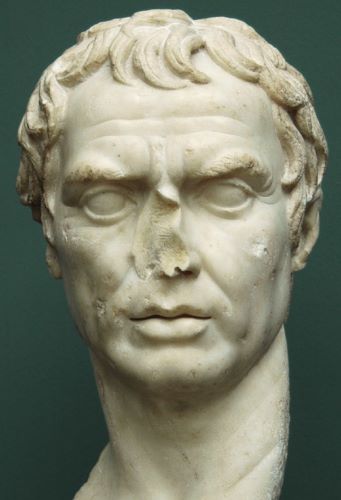
A brilliant Roman general named Scipio defeated the Carthaginian forces back in Spain in 207 BCE, cutting Hannibal off from both reinforcements and supplies, which weakened his army significantly. Scipio then attacked Africa itself, forcing Carthage to recall Hannibal to protect the city. Hannibal finally lost in 202 BCE after coming as close as anyone had to defeating the Romans. The victorious Scipio, now easily the most powerful man in Rome, became the first great general to add to his own name the name of the place he conquered: he became Scipio “Africanus” – conqueror of Africa.
An uneasy peace lasted for several decades between Rome and Carthage, despite enduring anti-Carthaginian hatred in Rome; one prominent senator named Cato the Elder reputedly ended every speech in the Senate with the statement “…and Carthage must be destroyed.” Rome finally forced the issue in the mid-second century BCE by meddling in Carthaginian affairs. The third and last Punic War that ensued was utterly one-sided: it began in 149 BCE, and by 146 BCE Carthage was defeated. Not only were thousands of the Carthaginian people killed or enslaved, but the city itself was brutally sacked (the comment by Polybius regarding the terror inspired by Rome, noted above, was specifically in reference to the horrific sack of Carthage). The Romans created a myth to commemorate their victory, claiming that they had “plowed the earth with salt” at Carthage so that nothing would ever grow there again – that was not literally true, but it did serve as a useful legend as the Romans expanded their territories even further.
Greece
Rome expanded eastward during the same period, eventually conquering all of Greece, the heartland of the culture the Romans so admired and emulated. While Hannibal was busy rampaging around Italy, the Macedonian King Philip V allied with Carthage against Rome, a reasonable decision at the time because it seemed likely that Rome was going to lose the war. In 201 BCE, after the defeat of the Carthaginians, Rome sent an army against Philip to defend the independence of Greece and to exact revenge. There, Philip and the king of the Seleucid empire (named Antiochus III) had agreed to divide up the eastern Mediterranean, assuming they could defeat and control all of the Greek poleis. An expansionist faction in the Roman senate successfully convinced the Centuriate Assembly to declare war. The Roman legions defeated the Macedonian forces without much trouble in 196 BCE and then, perhaps surprisingly, they left, having accomplished their stated goal of defending Greek independence. Rome continued to fight the Seleucids for several more years, however, finally reducing the Seleucid king Antiochus III to a puppet of Rome.
Despite having no initial interest in establishing direct control in Greece, the Romans found that rival Greek poleis clamored for Roman help in their conflicts, and Roman influence in the region grew. Even given Rome’s long standing admiration for Greek culture, the political and military developments of this period, from 196 – 168 BCE, helped confirm the Roman belief that the Greeks were artistic and philosophical geniuses but, at least in their present iteration, were also conniving, treacherous, and lousy at political organization. There was also a growing conservative faction in Rome led by Cato the Elder that emphatically emphasized Roman moral virtue over Greek weakness.
Philip V’s son Perseus took the throne of Macedon in 179 BCE and, while not directly threatening Roman power, managed to spark suspicion among the Roman elite simply by reasserting Macedonian sovereignty in the region. In 172 BCE Rome sent an army and Macedon was defeated in 168 BCE. Rome split Macedon into puppet republics, plundered Macedon’s allies, and lorded over the remaining Greek poleis. Revolts in 150 and 146 against Roman power served as the final pretext for the Roman subjugation of Greece. This time, the Romans enacted harsh penalties for disloyalty among the Greek cities, utterly destroying the rich city of Corinth and butchering or enslaving tens of thousands of Greeks for siding against Rome. The plunder from Corinth specifically also sparked great interest in Greek art among elite Romans, boosting the development of Greco-Roman artistic traditions back in Italy.
Thus, after centuries of warfare, by 140 BCE the Romans controlled almost the entire Mediterranean world, from Spain to Anatolia. They had not yet conquered the remaining Hellenistic kingdoms, namely those of the Seleucids in the Near East and the Ptolemies in Egypt, but they controlled a vast territory nonetheless. Even the Ptolemies, the most genuinely independent power in the region, acknowledged that Rome held all the real power in international affairs.
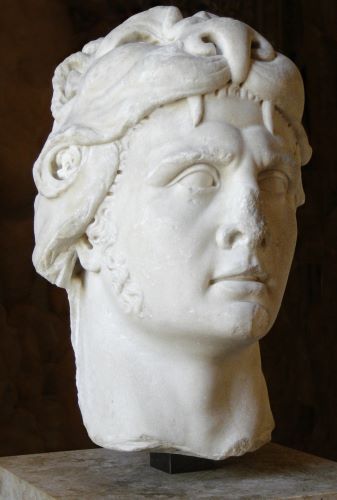
The last great Hellenistic attempt to push back Roman control was in the early first century BCE, with the rise of a Greek king, Mithridates VI, from Pontus, a small kingdom on the southern shore of the Black Sea. Mithridates led a large anti-Roman coalition of Hellenistic peoples first in Anatolia and then in Greece itself starting in 88 BCE. Mithridates was seen by his followers as a great liberator from Roman corruption (one Roman governor had molten gold poured down his throat to symbolize the just punishment of Roman greed). He went on to fight a total of three wars against Rome, but despite his tenacity he was finally defeated and killed in 63 BCE, the same year that Rome extinguished the last pitiful vestiges of the Seleucid kingdom.
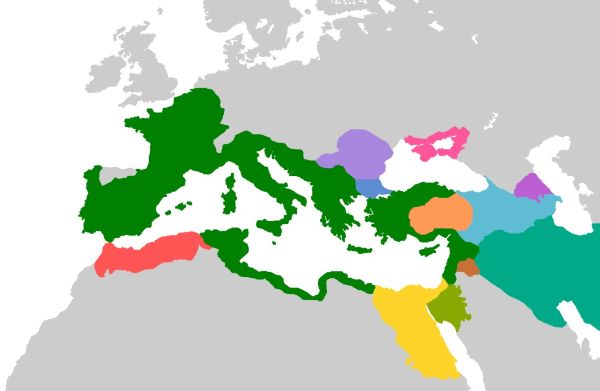
Under the leadership of a general and politician, Pompey (“the Great”), both Mithridates and the remaining independent formerly Seleucid territories were defeated and incorporated either as provinces or puppet states under the control of the Republic. With that, almost the entire Mediterranean region was under Rome’s sway – Egypt alone remained independent.
Greco-Roman Culture
The Romans had been in contact with Greek culture for centuries, ever since the Etruscans struck up their trading relationship with the Greek poleis of southern Italy. Initially, the Etruscans formed a conduit for trade and cultural exchange, but soon the Romans were trading directly with the Greeks as well as the various Greek colonies all over the Mediterranean. By the time the Romans finally conquered Greece itself, they had already spent hundreds of years absorbing Greek ideas and culture, modeling their architecture on the great buildings of the Greek Classical Age and studying Greek ideas.
Despite their admiration for Greek culture, there was a paradox in that Roman elites had their own self-proclaimed “Roman” virtues, virtues that they attributed to the Roman past, which were quite distinct from Greek ideas. Roman virtues revolved around the idea that a Roman was strong, honest, straightforward, and powerful, while the Greeks were (supposedly) shifty, untrustworthy, and incapable of effective political organization. The simple fact that the Greeks had been unable to forge an empire except during the brief period of Alexander’s conquests seemed to the Romans as proof that they did not possess an equivalent degree of virtue.
The Romans summed up their own virtues with the term Romanitas, which meant to be civilized, to be strong, to be honest, to be a great public speaker, to be a great fighter, and to work within the political structure in alliance with other civilized Romans. There was also a powerful theme of self-sacrifice associated with Romanitas – the ideal Roman would sacrifice himself for the greater good of Rome without hesitation. In some ways, Romanitas was the Romans’ spin on the old Greek combination of arete and civic virtue.
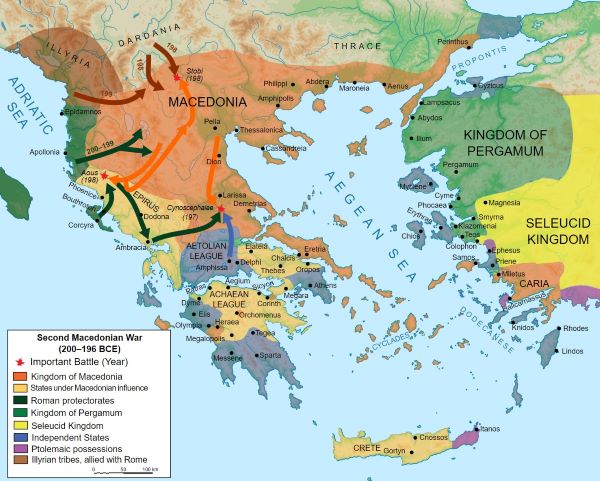
One example of Romanitas in action was the role of dictator. A Roman dictator, even more so than a consul, was expected to embody Romanitas, leading Rome through a period of crisis but then willingly giving up power. Since the Romans were convinced that anything resembling monarchy was politically repulsive, a dictator was expected to serve for the greater good of Rome and then step aside when peace was restored. Indeed, until the first century CE, dictators duly stepped down once their respective crises were addressed.
Romanitas was profoundly compatible with Greek Stoicism (which came of age in the Hellenistic monarchies just as Rome itself was expanding). Stoicism celebrated self-sacrifice, strength, political service, and the rejection of frivolous luxuries; these were all ideas that seemed laudable to Romans. By the first century BCE, Stoicism was the Greek philosophy of choice among many aristocratic Romans (a later Roman emperor, Marcus Aurelius, was even a Stoic philosopher in his own right).
The implications of Romanitas for political and military loyalty and morale are obvious. One less obvious expression of Romanitas, however, was in public building and celebrations. One way for elite (rich) Romans to express their Romanitas was to fund the construction of temples, forums, arenas, or practical public works like roads and aqueducts. Likewise, elite Romans would often pay for huge games and contests with free food and drink, sometimes for entire cities. This practice was not just in the name of showing off; it was an expression of one’s loyalty to the Roman people and their shared Roman culture. The creation of numerous Roman buildings (some of which survive) is the result of this form of Romanitas.
Despite their tremendous pride in Roman culture, the Romans still found much to admire about Greek intellectual achievements. By about 230 BCE, Romans started taking an active interest in Greek literature. Some Greek slaves were true intellectuals who found an important place in Roman society. One status symbol in Rome was to have a Greek slave who could tutor one’s children in the Greek language and Greek learning. In 220 BCE a Roman senator, Quintus Fabius Pictor, wrote a history of Rome in Greek, the first major work of Greek literature written by a Roman (like so many ancient sources, it has not survived). Soon, Romans were imitating the Greeks, writing in both Greek and Latin and creating poetry, drama, and literature.
That being noted, the interest in Greek culture was muted until the Roman wars in Greece that began with the defeat of Philip V of Macedon. Rome’s Greek wars created a kind of “feeding frenzy” of Greek art and Greek slaves. Huge amounts of Greek statuary and art were shipped back to Rome as part of the spoils of war, having an immediate impact on Roman taste. The appeal of Greek art was undeniable. Greek artists, even those who escaped slavery, soon started moving to Rome en masse because there was so much money to be made there if an artist could secure a wealthy patron. Greek artists, and the Romans who learned from them, adapted the Hellenistic Greek style. In many cases, classical statues were recreated exactly by sculptors, somewhat like modern-day prints of famous paintings. In others, a new style of realistic portraiture in sculpture that originated in the Hellenistic kingdoms proved irresistible to the Romans; whereas the Greeks of the Classical Age usually idealized the subjects of art, the Romans came to prefer more realistic and “honest” portrayals. We know precisely what many Romans looked like because of the realistic busts made of their faces: wrinkles, warts and all.
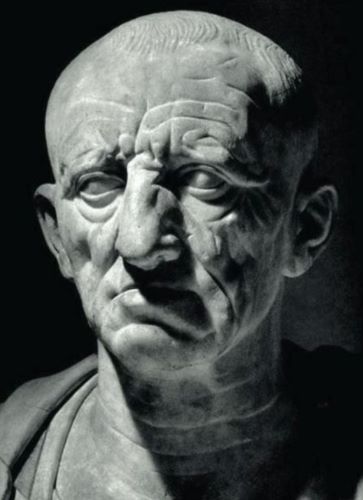
Along with philosophy and architecture, the most important Greek import to arrive on Roman shores was rhetoric: the mastery of words and language in order to persuade people and win arguments. The Greeks held that the two ways a man could best his rivals and assert his virtue were battle and public discussion and argumentation. This tradition was felt very keenly by the Romans, because those were precisely the two major ways the Roman Republic operated – the superiority of its armies was well-known, while individual leaders had to be able to convince their peers and rivals of the correctness of their positions. The Romans thus very consciously tried to copy the Greeks, especially the Athenians, for their skill at oratory.
Not surprisingly, the Romans both admired and resented the Greeks for the Greek mastery of words. The Romans came to pride themselves on a more direct, less subtle form of oratory than that (supposedly) practiced in Greece. Part of Roman oratorical skill was the use of passionate appeals to emotional responses in the audience, ones that were supposed to both harness and control the emotions of the speaker himself. The Romans also formalized instruction in rhetoric, a practice of studying the speeches of great speakers and politicians of the past and of debating instructors and fellow students in mock scenarios.
Roman Society
Much of Roman social life revolved around the system of clientage. Clientage consisted of networks of “patrons” – people with power and influence – and their “clients” – those who looked to the patrons for support. A patron would do things like arrange for his or her (i.e. there were women patrons, not just men) clients to receive lucrative government contracts, to be appointed as officers in a Roman legion, to be able to buy a key piece of farmland, and so on. In return, the patron would expect political support from their clients by voting as directed in the Centuriate or Plebeian Assembly, by influencing other votes, and by blocking political rivals. Likewise, clients who shared a patron were expected to help one another. These were open, publicly-known alliances rather than hidden deals made behind closed doors; groups of clients would accompany their patron into meetings of the senate or assemblies as a show of strength.
The government of the late Republic was still in the form of the Plebeian Assembly, the Centuriate Assembly, the Senate, ten tribunes, two consuls, and a court system under formal rules of law. By the late Republic, however, a network of patrons and clients had emerged that largely controlled the government. Elite families of nobles, through their client networks, made all of the important decisions. Beneath this group were the equestrians: families who did not have the ancient lineages of the patricians and who normally did not serve in public office. The equestrians, however, were rich, and they benefited from the fact that senators were formally banned from engaging in commerce as of the late third century BCE. They constituted the business class of Republican Rome who supported the elites while receiving various trade and mercantile concessions.

Meanwhile, the average plebeian had long ago lost his or her representation. The Plebeian Assembly was controlled by wealthy plebeians who were the clients of nobles. In other words, they served the interests of the rich and had little interest in the plight of the class they were supposed to represent. This created an ongoing problem for Rome, one that was exploited many times by populist leaders: Rome relied on a free class of citizens to serve in the army, but those same citizens often had to struggle to make ends meet as farmers. As the rich grew richer, they bought up land and sometimes even forced poorer citizens off of their farms. Thus, there was an existential threat to Rome’s armies, and with it, to Rome itself.
A comparable pattern existed in the territories – soon provinces – conquered in war. Rome was happy to grant citizenship to local elites who supported Roman rule, and sometimes entire communities could be granted citizenship on the basis of their loyalty (or simply their perceived usefulness) to Rome. Citizenship was a useful commodity, protecting its holders from harsher legal punishments and affording them significant political rights. Most Roman subjects, however, were just that: subjects, not citizens. In the provinces they were subject to the goodwill of the Roman governor, who might well look for opportunities to extract provincial wealth for his own benefit.
At the bottom of the Roman social system were the slaves. Slaves were one of the most lucrative forms of loot available to Roman soldiers, and so many lands had been conquered by Rome that the population of the Republic was swollen with slaves. Fully one-third of the population of Italy were slaves by the first century CE. Even freed slaves, called freedmen, had limited legal rights and had formal obligations to serve their former masters as clients. Roman slaves spanned the same range of jobs noted with other slaveholding societies like the Greeks: elite slaves lived much more comfortably than did most free Romans, but most were laborers or domestic servants. All could be abused by their owners without legal consequence.
Slavery was a huge economic engine in Roman society. Much of the “loot” seized in Roman campaigns was made up of human beings, and Roman soldiers were eager to capitalize on captives they took by selling them on returning to Italy. In historical hindsight, however, slavery undermined both Roman productivity and the pace of innovation in Roman society. It simply was not necessary to seek out new and better ways of doing things in the form of technological progress or social innovations because slave labor was always available. While Roman engineering was impressive, Rome developed no new technology to speak of in its thousand-year history. Likewise, the long-term effect of the growth of slavery in Rome was to undermine the social status of free Roman citizens, with farmers in particular struggling to survive as rich Romans purchased land and built huge slave plantations.
There were many slave uprisings, the most significant of which was led by Spartacus, a gladiator (warrior who fought for public amusement) originally from Thrace. Spartacus led the revolt of his gladiatorial school in the Italian city of Capua in 73 BCE. He set up a war camp on the slopes of the volcano Mt. Vesuvius, to which thousands of slaves fled, culminating in an “army” of about 70,000. He tried to convince them to flee over the Alps to seek refuge in their (mostly Celtic) homelands, but was eventually convinced to turn around to plunder Italy. The richest man in Italy, the senator Crassus, took command of the Roman army assembled to defeat Spartacus, crushing the slave army and killing Spartacus in 71 BCE (and lining the road to Rome with 6,000 crucified slaves).
In one area, however, Rome represented greater freedom and autonomy than did some of its neighboring societies (like Greece): gender roles. While Roman culture was explicitly patriarchal, with families organized under the authority of the eldest male of the household (the pater familias), there is a great deal of textual evidence that suggests that women enjoyed considerable independence nevertheless. Women retained the ownership of their dowries at marriage, could initiate divorce, and controlled their own inheritances. Widows, who were common thanks to the young marriage age of women and the death of soldier husbands, were legally autonomous and continued to run households after the death of the husband. Within families, women’s voices carried considerable weight, and in the realm of politics, while men held all official positions, women exercised considerable influence from behind the scenes.
It is easy to overstate women’s empowerment in Roman society; Roman culture celebrated the devoted mother and wife as the female ideal, and Roman traditionalists decried the loosening of strict gender roles that seems to have taken place over time during the Republic. Women were expected to be frugal managers of households and, in theory, they were to avoid ostentatious displays. Likewise, Roman law explicitly designated men as the official decision-makers within the family unit. That being noted, however, one of the reasons that we know that women did enjoy a higher degree of autonomy than in many other societies is the number of surviving texts that both described and, in many cases, celebrated the role of women. Those texts were written by both men and women, and most Romans (men very much included) felt that it was both appropriate and desirable for both boys and girls to be properly educated.
The End of the Republic
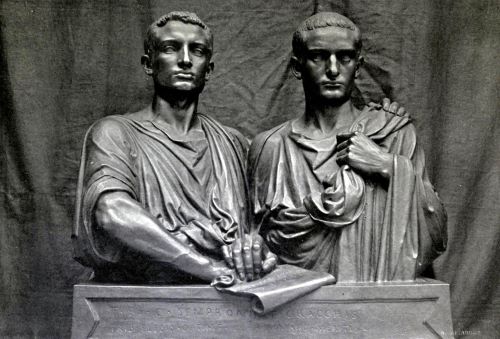
The Roman Republic lasted for roughly five centuries. It was under the Republic that Rome evolved from a single town to the heart of an enormous empire. Despite the evident success of the republican system, however, there were inexorable problems that plagued the Republic throughout its history, most evidently the problem of wealth and power. Roman citizens were, by law, supposed to have a stake in the Republic. They took pride in who they were and it was the common patriotic desire to fight and expand the Republic among the citizen-soldiers of the Republic that created, at least in part, such an effective army. At the same time, the vast amount of wealth captured in the military campaigns was frequently siphoned off by elites, who found ways to seize large portions of land and loot with each campaign. By around 100 BCE even the existence of the Plebeian Assembly did almost nothing to mitigate the effect of the debt and poverty that afflicted so many Romans thanks to the power of the clientage networks overseen by powerful noble patrons.
The key factor behind the political stability of the Republic up until the aftermath of the Punic Wars was that there had never been open fighting between elite Romans in the name of political power. In a sense, Roman expansion (and especially the brutal wars against Carthage) had united the Romans; despite their constant political battles within the assemblies and the senate, it had never come to actual bloodshed. Likewise, a very strong component of Romanitas was the idea that political arguments were to be settled with debate and votes, not clubs and knives. Both that unity and that emphasis on peaceful conflict resolution within the Roman state itself began to crumble after the sack of Carthage.
The first step toward violent revolution in the Republic was the work of the Gracchus brothers – remembered historically as the Gracchi (i.e. “Gracchi” is the plural of “Gracchus”). The older of the two was Tiberius Gracchus, a rich but reform-minded politician. Gracchus, among others, was worried that the free, farm-owning common Roman would go extinct if the current trend of rich landowners seizing farms and replacing farmers with slaves continued. Without those commoners, Rome’s armies would be drastically weakened. Thus, he managed to pass a bill through the Centuriate Assembly that would limit the amount of land a single man could own, distributing the excess to the poor. The Senate was horrified and fought bitterly to reverse the bill. Tiberius ran for a second term as tribune, something no one had ever done up to that point, and a group of senators clubbed him to death in 133 BCE.
Tiberius’s brother Gaius Gracchus took up the cause, also becoming tribune. He attacked corruption in the provinces, allying himself with the equestrian class and allowing equestrians to serve on juries that tried corruption cases. He also tried to speed up land redistribution. His most radical move was to try to extend full citizenship to all of Rome’s Italian subjects, which would have effectively transformed the Roman Republic into the Italian Republic. Here, he lost even the support of his former allies in Rome, and he killed himself in 121 BCE rather than be murdered by another gang of killers sent by senators.
The reforms of the Gracchi were temporarily successful: even though they were both killed, the Gracchi’s central effort to redistribute land accomplished its goal. A land commission created by Tiberius remained intact until 118 BCE, by which time it had redistributed huge tracts of land held illegally by the rich. Despite their vociferous opposition, the rich did not suffer much, since the lands in question were “public lands” largely left in the aftermath of the Second Punic War, and normal farmers did enjoy benefits. Likewise, despite Gaius’s death, the Republic eventually granted citizenship to all Italians in 84 BCE, after being forced to put down a revolt in Italy. In hindsight, the historical importance of the Gracchi was less in their reforms and more in the manner of their deaths – for the first time, major Roman politicians had simply been murdered (or killed themselves rather than be murdered) for their politics. It became increasingly obvious that true power was shifting away from rhetoric and toward military might.
A contemporary of the Gracchi, a general named Gaius Marius, took further steps that eroded the traditional Republican system. Marius combined political savvy with effective military leadership. Marius was both a consul (elected an unprecedented seven times) and a general, and he used his power to eliminate the property requirement for membership in the army. This allowed the poor to join the army in return for nothing more than an oath of loyalty, one they swore to their general rather than to the Republic. Marius was popular with Roman commoners because he won consistent victories against enemies in both Africa and Germany, and because he distributed land and farms to his poor soldiers. This made him a people’s hero, and it terrified the nobility in Rome because he was able to bypass the usual Roman political machine and simply pay for his wars himself. His decision to eliminate the property requirement meant that his troops were totally dependent on him for loot and land distribution after campaigns, undermining their allegiance to the Republic.
A general named Sulla followed in Marius’s footsteps by recruiting soldiers directly and using his military power to bypass the government. In the aftermath of the Italian revolt of 88 – 84 BCE, the Assembly took Sulla’s command of Roman legions fighting the Parthians away and gave it to Marius in return for Marius’s support in enfranchising the people of the Italian cities. Sulla promptly marched on Rome with his army, forcing Marius to flee. Soon, however, Sulla left Rome to command legions against the army of the anti-Roman king Mithridates in the east. Marius promptly attacked with an army of his own, seizing Rome and murdering various supporters of Sulla. Marius himself soon died (of old age), but his followers remained united in an anti-Sulla coalition under a friend of Marius, Cinna.
After defeating Mithridates, Sulla returned and a full-scale civil war shook Rome in 83 – 82 BCE. It was horrendously bloody, with some 300,000 men joining the fighting and many thousands killed. After Sulla’s ultimate victory he had thousands of Marius’s supporters executed. In 81 BCE, Sulla was named dictator; he greatly strengthened the power of the Senate at the expense of the Plebeian Assembly, had his enemies in Rome murdered and their property seized, then retired to a life of debauchery in his private estate (and soon died from a disease he contracted). The problem for the Republic was that, even though Sulla ultimately proved that he was loyal to republican institutions, other generals might not be in the future. Sulla could have simply held onto power indefinitely thanks to the personal loyalty of his troops.
Julius Caesar
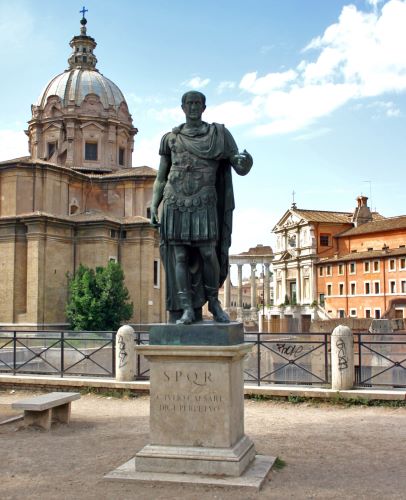
Thus, there is an unresolved question about the end of the Roman Republic: when a new politician and general named Julius Caesar became increasingly powerful and ultimately began to replace the Republic with an empire, was he merely making good on the threat posed by Marius and Sulla, or was there truly something unprecedented about his actions? Julius Caesar’s rise to power is a complex story that reveals just how murky Roman politics were by the time he became an important political player in about 70 BCE. Caesar himself was both a brilliant general and a shrewd politician; he was skilled at keeping up the appearance of loyalty to Rome’s ancient institutions while exploiting opportunities to advance and enrich himself and his family. He was loyal, in fact, to almost no one, even old friends who had supported him, and he also cynically used the support of the poor for his own gain.
Two powerful politicians, Pompey and Crassus (both of whom had risen to prominence as supporters of Sulla), joined together to crush the slave revolt of Spartacus in 70 BCE and were elected consuls because of their success. Pompey was one of the greatest Roman generals, and he soon left to eliminate piracy from the Mediterranean, to conquer the Jewish kingdom of Judea, and to crush an ongoing revolt in Anatolia. He returned in 67 BCE and asked the Senate to approve land grants to his loyal soldiers for their service, a request that the Senate refused because it feared his power and influence with so many soldiers who were loyal to him instead of the Republic. Pompey reacted by forming an alliance with Crassus and with Julius Caesar, who was a member of an ancient patrician family. This group of three is known in history as the First Triumvirate.
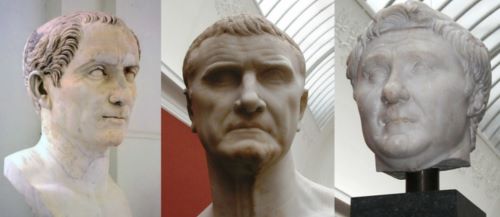
Each member of the Triumvirate wanted something specific: Caesar hungered for glory and wealth and hoped to be appointed to lead Roman armies against the Celts in Western Europe, Crassus wanted to lead armies against Parthia (i.e. the “new” Persian Empire that had long since overthrown Seleucid rule in Persia itself), and Pompey wanted the Senate to authorize land and wealth for his troops. The three of them had so many clients and wielded so much political power that they were able to ratify all of Pompey’s demands, and both Caesar and Crassus received the military commissions they hoped for. Caesar was appointed general of the territory of Gaul (present-day France and Belgium) and he set off to fight an infamous Celtic king named Vercingetorix.
From 58 to 50 BCE, Caesar waged a brutal war against the Celts of Gaul. He was both a merciless combatant, who slaughtered whole villages and enslaved hundreds of thousands of Celts (killing or enslaving over a million people in the end), and a gifted writer who wrote his own accounts of his wars in excellent Latin prose. His forces even invaded England, establishing a Roman territory there that lasted centuries. All of the lands he invaded were so thoroughly conquered that the descendants of the Celts ended up speaking languages based on Latin, like French, rather than their native Celtic dialects.
Caesar’s victories made him famous and immensely powerful, and they ensured the loyalty of his battle-hardened troops. In Rome, senators feared his power and called on Caesar’s former ally Pompey to bring him to heel (Crassus had already died in his ill-considered campaign against the Parthians; his head was used as a prop in a Greek play staged by the Parthian king). Pompey, fearing his former ally’s power, agreed and brought his armies to Rome. The Senate then recalled Caesar after refusing to renew his governorship of Gaul and his military command, or allowing him to run for consul in absentia.
The Senate hoped to use the fact that Caesar had violated the letter of republican law while on campaign to strip him of his authority. Caesar had committed illegal acts, including waging war without authorization from the Senate, but he was protected from prosecution so long as he held an authorized military command. By refusing to renew his command or allow him to run for office as consul, he would be open to charges. His enemies in the Senate feared his tremendous influence with the people of Rome, so the conflict was as much about factional infighting among the senators as fear of Caesar imposing some kind of tyranny.
Caesar knew what awaited him in Rome – charges of sedition against the Republic – so he simply took his army with him and marched off to Rome. In 49 BCE, he dared to cross the Rubicon River in northern Italy, the legal boundary over which no Roman general was allowed to bring his troops; he reputedly announced that “the die is cast” and that he and his men were now committed to either seizing power or facing total defeat. The brilliance of Caesar’s move was that he could pose as the champion of his loyal troops as well as that of the common people of Rome, whom he promised to aid against the corrupt and arrogant senators; he never claimed to be acting for himself, but instead to protect his and his men’s legal rights and to resist the corruption of the Senate.
Pompey had been the most powerful man in Rome, both a brilliant general and a gifted politician, but he did not anticipate Caesar’s boldness. Caesar surprised him by marching straight for Rome. Pompey only had two legions, both of whom had served under Caesar in the past and, and he was thus forced to recruit new troops. As Caesar approached, Pompey fled to Greece, but Caesar followed him and defeated his forces in battle in 48 BCE. Pompey himself escaped to Egypt, where he was promptly murdered by agents of the Ptolemaic court who had read the proverbial writing on the wall and knew that Caesar was the new power to contend with in Rome. Subsequently, Caesar came to Egypt and stayed long enough to forge a political alliance, and carry on an affair, with the queen of Egypt: Cleopatra VII, last of the Ptolemaic dynasty. Caesar helped Cleopatra defeat her brother (to whom she was married, in the Egyptian tradition) in a civil war and to seize complete control over the Egyptian state. She also bore him his only son, Caesarion.
Caesar returned to Rome two years later after hunting down Pompey’s remaining loyalists. There, he had himself declared dictator for life and set about creating a new version of the Roman government that answered directly to him. He filled the Senate with his supporters and established military colonies in the lands he had conquered as rewards for his loyal troops (which doubled as guarantors of Roman power in those lands, since veterans and their families would now live there permanently). He established a new calendar, which included the month of “July” named after him, and he regularized Roman currency. Then he promptly set about making plans to launch a massive invasion of Persia.
Instead of leading another glorious military campaign, however, in March of 44 BCE Caesar was assassinated by a group of senators who resented his power and genuinely desired to save the Republic. The result was not the restoration of the Republic, however, just a new chapter in the Caesarian dictatorship. Its architect was Caesar’s heir, his grand-nephew Octavian, to whom Caesar left (much to almost everyone’s shock) almost all of his vast wealth.
Mark Antony and Octavian
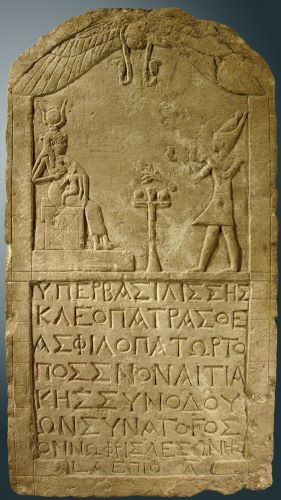
Following his death, Caesar’s right-hand man, a skilled general named Mark Antony, joined with Octavian and another general named Lepidus to form the “Second Triumvirate.” In 43 BCE they seized control in Rome and then launched a successful campaign against the old republican loyalists, killing off the men who had killed Caesar and murdering the strongest senators and equestrians who had tried to restore the old institutions. Mark Antony and Octavian soon pushed Lepidus to the side and divided up control of Roman territory – Octavian taking Europe and Mark Antony taking the eastern territories and Egypt. This was an arrangement that was not destined to last; the two men had only been allies for the sake of convenience, and both began scheming as to how they could seize total control of Rome’s vast empire.
Mark Antony moved to the Egyptian city of Alexandria, where he set up his court. He followed in Caesar’s footsteps by forging both a political alliance and a romantic relationship with Cleopatra, and the two of them were able to rule the eastern provinces of the Republic in defiance of Octavian. In 34 BCE, Mark Antony and Cleopatra declared that Cleopatra’s son by Julius Caesar, Caesarion, was the heir to Caesar (not Octavian), and that their own twins were to be rulers of Roman provinces. Rumors in the west claimed that Antony was under Cleopatra’s thumb (which is unlikely: the two of them were both savvy politicians and seem to have shared a genuine affection for one another) and was breaking with traditional Roman values, and Octavian seized on this behavior to claim that he was the true protector of Roman morality. Soon, Octavian produced a will that Mark Antony had supposedly written ceding control of Rome to Cleopatra and their children on his death; whether or not the will was authentic, it fit in perfectly with the publicity campaign on Octavian’s part to build support against his former ally in Rome.
When he finally declared war in 32 BCE, Octavian claimed he was only interested in defeating Cleopatra, which led to broader Roman support because it was not immediately stated that it was yet another Roman civil war. Antony and Cleopatra’s forces were already fairly scattered and weak due to a disastrous campaign against the Persians a few years earlier. In 31 BCE, Octavian defeated Mark Antony’s forces, which were poorly equipped, sick, and hungry. Antony and Cleopatra’s soldiers were starved out by a successful blockade engineered by Octavian and his friend and chief commander Agrippa, and the unhappy couple killed themselves the next year in exile. Octavian was 33. As his grand-uncle had before him, Octavian began the process of manipulating the institutions of the Republic to transform it into something else entirely: an empire.
Transition to Empire
One of the peculiar things about the Roman Republic is that its rise to power was in no way inevitable. No Roman leader had a “master plan” to dominate the Mediterranean world, and the Romans of 500 BCE would have been shocked to find Rome ruling over a gigantic territory a few centuries later. Likewise, the demise of the Republic was not inevitable. The class struggles and political rivalries that ultimately led to the rise of Caesar and then to the true transformation brought about by Octavian could have gone very differently. Perhaps the most important thing that Octavian could, and did, do was to recognize that the old system was no longer working the way it should, and he thus set about deliberately creating a new system in its place. For better or for worse, by the time of his death in 14 CE, Octavian had permanently dismantled the Republic and replaced it with the Roman Empire.
When Octavian succeeded in defeating Marc Antony, he removed the last obstacle to his own control of Rome’s vast territories. While paying lip service to the idea that the Republic still survived, he in fact replaced the republican system with one in which a single sovereign ruled over the Roman state. In doing so he founded the Roman Empire, a political entity that would survive for almost five centuries in the west and over a thousand years in the east.
This system was called the Principate, rule by the “First.” Likewise, although “Caesar” had originally simply been the family name of Julius Caesar’s line, “Caesar” came to be synonymous with the emperor himself by the end of the first century CE. The Roman terms for rule would last into the twentieth century CE: the imperial titles of the rulers of both Russia and Germany – “Tsar” and “Kaiser” – meant “Caesar.” In turn, the English word “emperor” derives from imperator, the title of a victorious Roman general in the field, which was adopted as yet another honorific by the Roman emperors. The English word “prince” is another Romanism, from Princeps Civitatis, “First Citizen,” the term that Augustus invented for himself. For the sake of clarity, this article will use the anglicized term “emperor” to refer to all of the leaders of the Roman imperial system.
Augustus
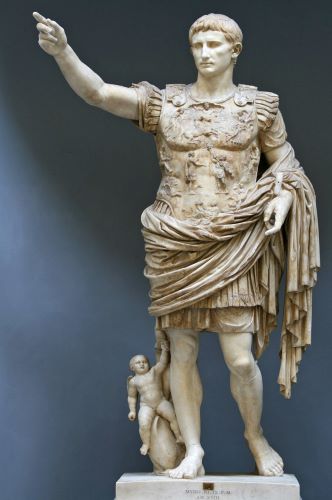
The height of Roman power coincided with the first two hundred years of the Roman Empire, a period that was remembered as the Pax Romana: the Roman Peace. It was possible during the period of the Roman Empire’s height, from about 1 CE to 200 CE, to travel from the Atlantic coast of Spain or Morocco all the way to Mesopotamia using good roads, speaking a common language, and enjoying official protection from banditry. The Roman Empire was as rich, powerful, and glorious as any in history up to that point, but it also represented oppression and imperialism to slaves, poor commoners, and conquered peoples.
Octavian was unquestionably the architect of the Roman Empire. Unlike his great-uncle, Julius Caesar, Octavian eliminated all political rivals and set up a permanent hereditary emperorship. All the while, he claimed to be restoring not just peace and prosperity, but the Republic itself. Since the term Rex (king) would have been odious to his fellow Romans, Augustus instead referred to himself as Princeps Civitatus, meaning “first citizen.” He used the Senate to maintain a facade of republican rule, instructing senators on the actions they were to take; a good example is that the Senate “asked” him to remain consul for life, which he graciously accepted. By 23 BCE, he assumed the position of tribune for life, the position that allowed unlimited power in making or vetoing legislation. All soldiers swore personal oaths of loyalty to him, and having conquered Egypt from his former ally Mark Antony, Augustus was worshiped there as the latest pharaoh. The Senate awarded Octavian the honorific Augustus: “illustrious” or “semi-divine.” It is by that name, Augustus Caesar, that he is best remembered.
Despite his obvious personal power, Augustus found it useful to maintain the facade of the Republic, along with republican values like thrift, honesty, bravery, and honor. He instituted strong moralistic laws that penalized (elite) young men who tried to avoid marriage and he celebrated the piety and loyalty of conservative married women. Even as he converted the government from a republic to a bureaucratic tool of his own will, he insisted on traditional republican beliefs and republican culture. This no doubt reflected his own conservative tastes, but it also eased the transition from republic to autocracy for the traditional Roman elites.
As Augustus’s powers grew, he received an altogether novel legal status, imperium majus, that was something like access to the extraordinary powers of a dictator under the Republic. Combined with his ongoing tribuneship and direct rule over the provinces in which most of the Roman army was garrisoned at the time, Augustus’s practical control of the Roman state was unchecked. As a whole, the legal categories used to explain and excuse the reality of Augustus’s vast powers worked well during his administration, but sometimes proved a major problem with later emperors because few were as competent as he had been. Subsequent emperors sometimes behaved as if the laws were truly irrelevant to their own conduct, and the formal relationship between emperor and law was never explicitly defined. Emperors who respected Roman laws and traditions won prestige and veneration for having done so, but there was never a formal legal challenge to imperial authority. Likewise, as the centuries went on and many emperors came to seize power through force, it was painfully apparent that the letter of the law was less important than the personal power of a given emperor in all too many cases.
This extraordinary power did not prompt resistance in large part because the practical reforms Augustus introduced were effective. He transformed the Senate and equestrian class into a real civil service to manage the enormous empire. He eliminated tax farming and replaced it with taxation through salaried officials. He instituted a regular messenger service. His forces even attacked Ethiopia in retaliation for attacks on Egypt and he received ambassadors from India and Scythia (present-day Ukraine). In short, he supervised the consolidation of Roman power after the decades of civil war and struggle that preceded his takeover, and the large majority of Romans and Roman subjects alike were content with the demise of the Republic because of the improved stability Augustus’s reign represented. Only one major failure marred his rule: three legions (perhaps as many as 20,000 soldiers) were destroyed in a gigantic ambush in the forests of Germany in 9 CE, halting any attempt to expand Roman power past the Rhine and Danube rivers. Despite that disaster, after Augustus’s death the senate voted to deify him: like his great-uncle Julius, he was now to be worshipped as a god.
The Imperial Dynasties
Overview
The period of the Pax Romana included three distinct dynasties:
- The Julian dynasty: 14 – 68 CE – those emperors related (by blood or adoption) to Caesar’s line.
- The Flavian dynasty: 69 – 96 CE – a father and his two sons who seized power after a brief civil war.
- The “Five Good Emperors”: 96 – 180 CE – a “dynasty” of emperors who chose their successors, rather than power passing to their family members.
The Julio-Claudian Dynasty
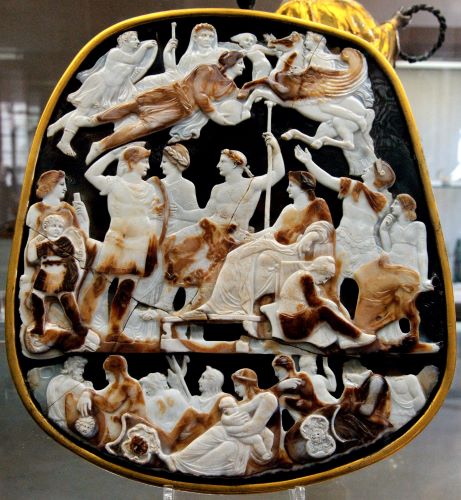
There is a simple and vexing problem with any discussion of the Roman emperors: the sources. While archaeology and the surviving written sources create a reasonably clear basis for understanding the major political events of the Julian dynasty, the biographical details are much more difficult. All of the surviving written accounts about the lives of the Julian emperors were written many decades, in some cases more than a century, after their reign. In turn, the two most important biographers, Tacitus and Suetonius, detested the actions and the character of the Julians, and thus their accounts are rife with scandalous anecdotes that may or may not have any basis in historical truth (Tacitus is universally regarded as the more reliable, although Suetonius’s The Twelve Caesars does make for very entertaining reading). Thus, the biographical sketches below are an attempt to summarize what is known for sure, along with some notes on the scandalous assertions that may be at least partly fabricated.
When Augustus died in 14 CE, his stepson Tiberius (r. 14 – 37 CE) became emperor. While it was possible that the Senate might have tried to reassert its power, there was no political will to do so. Only idealistic or embittered senators really dreamed of restoring the Republic, and a coup would have been rejected by the vast majority of Roman citizens. Under the Caesars, after all, the empire had never been more powerful or wealthy. Genuine concessions had been made to the common people, especially soldiers, and the only people who really lost out in the short term were the old elite families of patricians, who no longer had political power independent of the emperor (although they certainly retained their wealth and status).
Tiberius began his rule as a cautious leader who put on a show of only reluctantly following in Augustus’s footsteps as emperor. He was a reasonably competent emperor for over a decade, delegating decisions to the Senate and ensuring that the empire remained secure and financially solvent. In addition, he oversaw a momentous change to the priorities of the Roman state: the Roman Empire no longer embarked on a sustained campaign of expansion as it had done ever since the early decades of the Republic half a millennium earlier. This does not appear to have been a conscious policy choice on the part of Tiberius, but instead a shift in priorities: the Senate was now staffed by land-owning elites who did not predicate their identities on warfare, and Tiberius himself saw little benefit in warring against Persia or invading Germany (he also feared that successful generals might threaten his power, at one point ordering one to call off a war in Germany). The Roman Empire would continue to expand at times in the following centuries, but never to the degree or at the pace that it had under the Republic.
Eventually, Tiberius retreated to a private estate on the island of Capri (off the west coast of Italy). Suetonius’s biography would have it that on Capri, Tiberius indulged his penchant for bloodshed and sexual abuse, which is highly questionable – what is not questionable is that Tiberius became embittered and suspicious, ordering the murders of various would-be claimants to his throne back in Rome, and sometimes ignoring affairs of state. When he died, much to the relief of the Roman populace, great hopes were pinned on his heir.
That heir was Gaius (r. 37 – 41 CE), much better known as “Caligula,” literally meaning “little boots” but which translates best as “bootsie.” As a boy, Caligula moved with his father, a famous and well-liked general related by marriage to the Julians, from army camp to army camp. While he did so he liked to dress up in miniature legionnaire combat boots; hence, he was affectionately dubbed “Bootsie” by the troops (one notable translation of the work of Suetonius by Robert Graves translates Caligula as “Bootikins” instead).
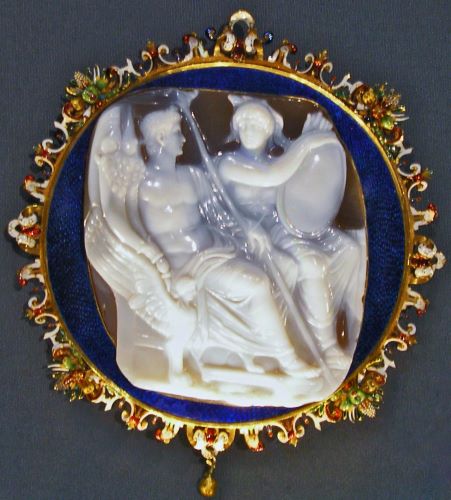
Even if some of the stories of his personal sadism are exaggerated, there is no doubt that Caligula was a disastrous emperor. According to the biographers, Caligula quickly earned a reputation for cruelty and megalomania, enjoying executions (or simple murders) as forms of entertainment and spending vast sums on shows of power. Convinced of his own godhood, Caligula had the heads of statues of the gods removed and replaced with his own head. He liked to appear in public dressed as various gods or goddesses; one of his high priests was his horse, Incitatus, whom he supposedly appointed as a Roman consul. He staged an invasion of northern Gaul of no tactical significance which culminated in a Triumph (military parade, traditionally one of the greatest demonstrations of power and glory of a victorious general) back in Rome.
Much of the scandalous gossip about him, historically, is because he was unquestionably the enemy of the Senate, seeing potential traitors everywhere and inflicting waves of executions against former supporters. He used trials for treason to enrich himself after squandering the treasury on buildings and public games. He also made senators wait on him dressed as slaves, and demanded that he be addressed as “dominus et deus,” meaning “master and god.” He was finally murdered by a group of senators and guardsmen.
The next emperor was Claudius (r. 41 – 54 CE), the one truly competent emperor of the Julian line after Augustus. Claudius had survived palace intrigues because he walked with a limp and spoke with a pronounced stutter; he was widely considered to be a simpleton, whereas he was actually highly intelligent. Once in power Claudius proved himself a competent and refreshingly sane emperor, ending the waves of terror Caligula had unleashed. He went on to oversee the conquest of England, first begun by Julius Caesar decades earlier. He was also a scholar, mastering the Etruscan and Punic languages and writing histories of those two civilizations (the histories are now lost, unfortunately). He restored the imperial treasury, depleted by Tiberius and Caligula, and maintained the Roman borders. He also established a true bureaucracy to manage the vast empire and began the process of formally distinguishing between the personal wealth of the emperor and the official budget of the Roman state.
According to Roman historians, Claudius was eventually betrayed and poisoned by his wife, who sought to have her son from another marriage become emperor. That son was Nero. Nero (r. 54 – 68 CE) was another Julian who acquired a terrible historical reputation; while he was fairly popular during his first few years as emperor, he eventually succumbed to a Caligula-like tendency of having elite Romans (including his domineering mother) killed. In 64 CE, a huge fire nearly destroyed the city, which was largely built out of wood. This led to the legend of Nero “playing his fiddle while Rome burned” – in fact, in the fire’s aftermath Nero had shelters built for the homeless and set about rebuilding the roughly half of the city that had been destroyed, using concrete buildings and grid-based streets. That said, he did use space cleared by the fire to begin the construction of a gigantic new palace in the middle of Rome called the “golden house,” into which he poured state revenues.
Nero’s terrible reputation arose from the fact that he unquestionably hounded and persecuted elite Romans, using a law called the Maiestas that made it illegal to slander the emperor to extract huge amounts of money from senators and equestrians. He also ordered imagined rivals and former advisors to kill themselves, probably out of mere jealousy. Besides Roman elites, his other major target was the early Christian movement, whom he blamed for the fire in Rome and whom he relentlessly persecuted (thousands were killed in the gladiatorial arena, ripped apart by wild animals). Thus, the two groups in the position to write Nero’s history – elite Romans and early Christians – had every reason to hate him. In addition, Nero took great pride in being an actor and musician, two professions that were considered by Roman elites to be akin to prostitution. His artistic indulgences were thus scandalous violations of elite sensibilities. After completely losing the support of both the army and the Senate, Nero committed suicide in 68 CE.
Another note on the sources: what the “bad” emperors of the Julian line (Tiberius, Caligula, and Nero) had in common is that they violated the old traditions of Romanitas, squandering wealth and glorifying themselves in various ways, thus inspiring hostility from many elite Romans. Since it was other elite Romans (albeit many years later) who became their biographers, we in the present cannot help but have a skewed view of their conduct. Historians have rehabilitated much of the rule of Tiberius and (to a lesser extent) Nero in particular, arguing that even if they were at loggerheads with the Senate at various times and probably did unfairly prosecute at least some senators, they did a decent job of running the empire as well.
The Flavian Dynasty
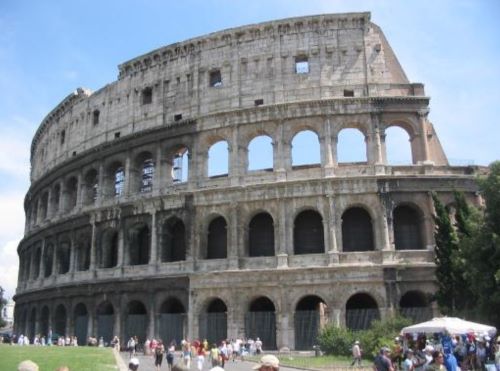
In the aftermath of Nero’s death, a brief civil war broke out. Four generals competed for the emperorship, supported by their armies. In the end, a general named Vespasian (r. 69 – 79 CE) seized power and founded a fairly short-lived dynasty consisting of himself and his two sons, known to history as the Flavians. The importance of Vespasian’s takeover was that it reinforced the idea that real power in Rome was no longer that of the old power-broking families, but instead the armies; Vespasian had no legal claim to the throne, but his emperorship was ratified by the Senate nevertheless. The emperor’s major concern had to be maintaining the loyalty of the armies above all else, because they could and would openly fight to put their man on the throne in a time of crisis – this occurred numerous times in the centuries to come.
Vespasian was one of the great emperors of the early empire. He pulled state finances back from the terrible state they had been left in by Nero and restored the relationship between the emperor and the Roman elite; it certainly did not hurt his reputation that he was a successful general, one of the traditional sources of status among Roman leaders. He was also renowned for his openness and his grounded outlook. Reputably, he did not keep a guard and let people speak to him directly in public audiences. In an act of classic Romanitas, he started work on the famous Colosseum (known at the time as the Flavian Amphitheater) in Rome in order to provide a grand setting for public games and performances. All of this happened in just a decade; he died of natural causes in 79 CE.
Vespasian’s older son Titus (r. 79 – 81 CE) had been groomed to follow his father and began as a promising and competent emperor. Unfortunately, almost as soon as he took the throne a volcano in southern Italy, Mt. Vesuvius, erupted, followed shortly by another huge fire as well as an epidemic in Rome. Titus struggled to aid victims of all three disasters, but was then struck by fever and died in 81 CE.
Vespasian’s second son, Domitian (r. 81 – 96 CE), who was not “supposed” to take the throne, proved to be a terrible ruler. He created an atmosphere of terror in elite Roman circles in an effort to watch out for potential rebels, murdering senators and elites he suspected. He adopted a Caligula-like concern for glorifying himself (like Caligula, he insisted that he be addressed as “dominus et deus”) and liked to appear before the senate in the armor of a Roman commander returning from victory. He was moralistic about both sex and the divinity of the emperors, instituting the policy that all oaths had to be sword to the godhood of the emperor. About the only positive undertaking in his rule was major building projects, both for palaces for himself and public works (including roads and fortifications), and it is also worth noting that the empire remained under a stable administration during his reign. That noted, Domitian became increasingly paranoid and violent between 89 and 96 CE, until he was finally killed by assassins in the palace.
The “Five Good Emperors” and the Severans
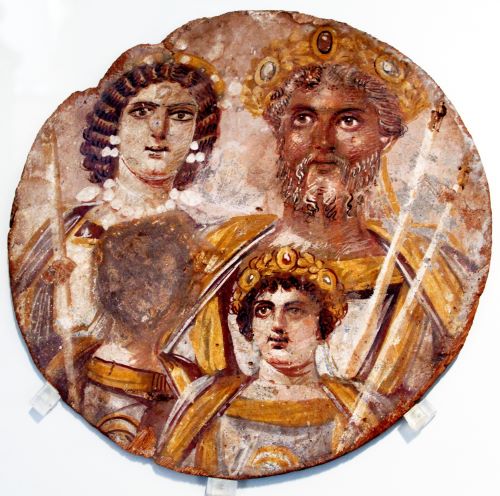
Following the work of the great eighteenth-century English historian Edward Gibbon, historians frequently refer to the rulers of the Roman Empire who followed the death of Domitian as the “Five Good Emperors,” those who successfully managed the Empire at its height. For almost a century, emperors appointed their own successors from the most competent members of the younger generation of Roman elites. Not least because none of them (except the last, to disastrous consequences) had surviving direct heirs of their own, each emperor would adopt a younger man as his son, thereby ensuring his succession. Rome prospered during this period under this relatively meritocratic system of political succession. It was under one of these emperors, Trajan, that the empire achieved its greatest territorial expanse.
One of the important aspects of the behavior of the “good emperors” is that they fit the model of a “philosopher-king” first described by Plato centuries earlier. Even though monarchy had been repugnant to earlier Romans, during the period of the Republic, the good emperors tried to live and act according to traditional Roman Romanitas, undertaking actions not only for their own glorification but for the good of the Roman state. The borders were maintained (or, as under Trajan, expanded), public works and infrastructure built, and infighting among elites kept to a minimum.
Trajan’s accomplishments deserve special mention, not only because of his success in expanding the Empire, but in how he governed it. He was a fastidious and straightforward administrator, focusing his considerable energies on the practical business of rule. He personally responded to requests and correspondence, he instituted a program of inexpensive loans to farmers and used the interest to pay for food for poor children, and he worked closely and successfully with the Senate to maintain stability and imperial solvency. The fact that personally led the legions on major military campaigns capped his reign in the military glory expected of an emperor following the rule of the Flavians, but he was remembered at least as well for his skill as a leader in peacetime.
The next two emperors, Hadrian and Antoninus Pius, did not win comparable military glory, but they did defend the borders (Hadrian gave up Trajan’s conquests in Mesopotamia to do so, recognizing that they were unsustainable), oversaw major building projects, and maintained Roman stability. Hadrian spent much of his reign touring the Roman provinces, particularly Greece. It was clear by his reign that the emperor’s authority was practically limitless, with both emperors issuing imperial proclamations known as “rescripts” while away from Rome that carried the force of law.
This period of successful rule eventually broke down when the practice of choosing a competent follower ended – the emperor Marcus Aurelius, a brilliant leader and Stoic philosopher (161 – 180 CE) named his arrogant and foolish son Commodus (r. 177 – 192 CE) his co-emperor three years before Aurelius’s death. Storm clouds had already been gathering under Aurelius, who found himself obliged to lead military campaigns against incursions of Germanic tribes in the north despite his own lack of a military background (or, really, temperament). He had, however, been a scrupulously efficient and focused political leader. His decision to make Commodus his heir was due to a simple fact: Aurelius was the first of the Five Good Emperors to have a biological son who survived to adulthood. As emperor, Commodus indulged his taste for debauchery and ignored affairs of state, finally being assassinated after twelve years of incompetence.
One last dynasty emerged in the aftermath of Commodus’s death, that of the Severans who ruled from 192 – 235 CE. They faced growing threats on the Roman borders, as Germanic tribes staged repeated (and often at least temporarily successful) incursions to the north and a new Persian dynasty known as the Sasanians pressed against Roman territory to the east. The last Severan emperor, Severus Alexander, died in 235 CE, ushering in a terrible period of military defeat and instability.
Beyond the Empire
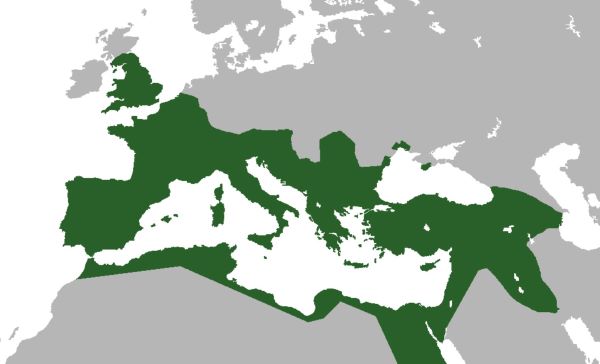
As noted above, by the year 117 CE under Trajan the Empire reached its greatest size. It encompassed most of England across to Germany and Romania, all of North Africa from present-day Morocco, and extended to the borders of the Persian Empire. Beyond these borders were “barbarians” of various kinds; as far as the Romans were concerned there were no civilized people outside of their borders except the Persians. Trajan’s successor, the emperor Hadrian, built an enormous series of fortifications to consolidate power on the frontiers – these were eventually (by the third century CE) known as the limes, permanent garrisons and fortresses that were meant to serve as barriers to prevent “barbarian” incursions. Some of these survive to the present, including Hadrian’s Wall in northern England. While fleets patrolled the rivers and oceans, these garrisons controlled access to the empire.
As far as the Romans were concerned, there were only two things beyond those borders: to the north and northeast, endless tracts of inhospitable land and semi-human barbarians like the Germanic tribes, and to the east, the only other civilization Rome was prepared to recognize: the Persians, ruled first by the Parthians and then the Sasanians. For the rest of the Roman Imperial period, Rome and Persia periodically engaged in both raiding and full-scale warfare, with neither side proving capable of conclusively defeating the other.
Persia under the Parthians
Parthian history is difficult to establish because almost no sources survive besides Roman and Greek accounts of battle against the Parthians. What is clear is that the Parthians deliberately built on the achievements of the earlier Achaemenid and Seleucid periods, adopting the title of king of kings, basing their empire (as of the 120s BCE) out of Ctesiphon, a city near Babylon in Mesopotamia, and ruling over a shifting confederation of both the settled peoples of Mesopotamia and Persia itself and of nomadic tribal confederations. Importantly, the Parthians were able to clinch control of major Silk Road trade routes, even receiving the first ever formal diplomatic contact with China in the West in the process, and thus had a solid economic foundation for their military and political control of the region.
Persia had long stood as the only adversary Rome was unable to defeat. In a stark contrast to Roman tactics, Persia relied on cavalry instead of infantry, including both heavy, armored lancers and highly mobile mounted bowmen. Persian forces refused to engage in hand combat with Roman soldiers whenever possible and simply rained arrows on them from horseback instead (using compound bows capable of penetrating Roman armor). Probably the most notorious Roman defeat was that of the forces led by Crassus, Julius Caesar’s ally in the First Triumvirate. In 53 BCE at a site known as Carrhae, the Persians slew 20,000 Roman troops, took 10,000 prisoners, and killed Crassus to boot. That battle led to a grudging admiration on the part of the Romans, who were forced to acknowledge that they had finally met their match.
The closest Rome came to defeating the Persians was under Trajan when he managed to conquer Armenia and parts of Mesopotamia, but after his death Rome swiftly abandoned those territories. Even as they fought, however, Persia and Rome still traded, and Rome also adopted various Persian technologies and military tactics (for example, Rome adopted irrigation techniques from Persia, and Persia adopted engineering techniques from Rome). Out of necessity, Rome learned to add heavy cavalry units to its legions by the fourth century CE.
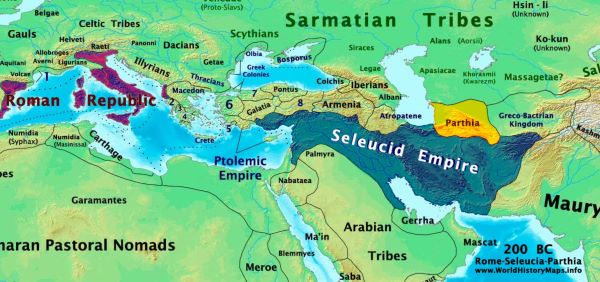
Little else is known about Persia during the Parthian period. The Roman sources would have it that the power of the ruling dynasty was limited by both court intrigue and the frequency of invasions from the steppes (the usual problem for the settled dynasties of Mesopotamia and Persia going back to the very origins of civilization). Both war and trade came and went between Rome and Persia, with the Euphrates River existing as the usual boundary between the two empires and the nearby kingdom of Armenia as a buffer state dominated by one power and then the other over time. In 224 CE the last Parthian ruler was overthrown by Ardashir I, the leader of the Sasanian clan, and Persian history moved into a new phase under Sasanian rule.
Farther East and North
Far beyond Persia was the Chinese Empire, already thousands of years old. China and Rome never established formal diplomatic ties, although the leaders of both empires knew of one another. During the entire period of Roman Imperial power, only China could produce silk, which was highly coveted in Rome. Shipments of silk moved along the aptly-named Silk Road across Central Asia, directly linking the two most powerful empires in the world at the time (via, as mentioned above, Persia, which derived huge profits in the process).
In addition, a major navigational breakthrough occurred during the time of Augustus, when the Romans learned to navigate the Indian Ocean using the Monsoon winds to reach western India. There, they could trade for Chinese silk at much better prices. This journey was hugely risky, but if a Roman merchant could pull it off and return to Rome with a cargo hold full of silk, he would earn fully 100 times his investment as profit. Along with spices (especially pepper), the trade for silk eventually drained enormous amounts of gold from Rome, something that added up to a serious economic liability over the hundreds of years of exchange.
The most important, and threatening, border for Rome was to its north, on the eastern and northern banks of the Rhine and Danube rivers. The region the Romans called Germania was an enormous stretch of heavily forested land, which was cold, wet, and uninviting from the Roman perspective. The “Germans” were a hugely diverse group of tribes practicing feudal law, the system of law in which offenses were met with clan-based violent retribution or blood payments. For hundreds of years there were complex relationships between various tribes and the Roman empire in which the Romans both fought with and, increasingly, hired German tribes to serve as mercenaries. Eventually, some of the Germanic tribes were allowed to settle along the Roman borders in return for payments of tribute to Rome.
The two major rivers, the Rhine and the Danube, were the key dividing lines to the north of Rome, with Roman legions manning permanent fortifications there. As far as the Romans were concerned, even if they were able to militarily they did not want to conquer German territory. The Romans tended to regard the Germans as being semi-human at best, incapable of understanding true civilization. Some Romans did admire their bravery and codes of honor – the same Tacitus who provides much of the information on the early emperors contrasted the supposed weakness and dissolution of his contemporary Romans with the rough virtue of the Germans. That being noted, most Romans believed that the Celts, conquered by Caesar centuries earlier, were able to learn and assimilate to Roman culture, but the Germans, supposedly, were not. Likewise, Germania was assumed to be too cold, too wet, and too infertile to support organized farming and settlement. Thus, the role of the limes was to hold the Germans back rather than to stage new wars of conquest. For about three hundred years, they did just that, until the borders started breaking down by the third century CE.
The Army and Assimilation
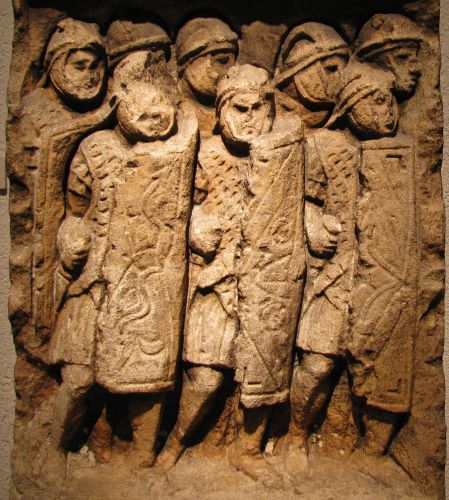
Rome had established control over its vast territory thanks to the strength of the citizen-soldiers of the Republic. The republican military system declined after the Punic Wars as the number of free, economically independent Roman citizens capable of serving in the army diminished. By the first century, most Roman soldiers became career soldiers loyal to a specific general who promised tangible rewards rather than volunteers who served only in a given campaign and then returned home to their farms.
Perhaps the most important thing Augustus did besides establishing the principate itself was to reorganize the Roman legions. He created a standing professional army with regular pay and retirement benefits, permanently ending the reliance on the volunteer citizen – soldiers that had fought for Rome under the republic. Instead, during the empire, Legionaries served for twenty years and then were put on reserve for another five, although more than half died before reaching retirement age. The major benefits of service were a very large bonus paid on retirement (equivalent to 13 years of pay!) and land: military colonies spread across the empire ensured that a loyal soldier could expect to establish a prosperous family line if he lived that long.
Service in the army was grueling and intense. Roman soldiers were expected to be able to march over 20 miles in a standard day’s march carrying a heavy pack. They were subject to brutal discipline, up to and including summary execution if they were judged to have been derelict in their duties – one of the worst was falling asleep on guard duty, punishable by being beaten to death by one’s fellow soldiers. Roman soldiers were held to the highest standards of unit cohesion, and their combat drills meant they were constantly ready for battle.
Starting in the Augustan period, the essential division in the Roman military was the legion, a self-sufficient army unto itself that could be combined with other legions to form a full-scale invasion force but could also operate on its own. During the Augustan period, each legion consisted of 5,400 infantry and 120 cavalry, along with hundreds of specialists such as engineers, arrow-makers, and blacksmiths who allowed the legion to operate independently while traveling. The legions were subdivided into cohorts of 480 men, each of which was led by a centurion, veterans who had risen through the ranks to lead. The legions were designed to be flexible, adaptable, and “standardized”: each legion was comparable in its organization, down to the placement of the tents in the camps built at the end of every day while the legion was on the march.
In turn, each legion was led by a legionary legate, usually a powerful noble appointed by the imperial government or the emperor himself. These legates were often politicians rather than soldiers, meaning that the key figures in actual battle were the centurions, each of whom had earned his position through exemplary service. Perhaps most important of all was the lead centurion, the First Spear, who dictated tactics on the field.
The legions were made up of Roman citizens, but not all members of the Roman military were citizens. Instead, as numerous as the legions were auxiliaries: Roman subjects (e.g. Celts, North Africans, Syrians, etc.). who nevertheless served the empire. The auxiliaries were divided into cohorts of infantry and alae (“wings”) of cavalry. In comparison to the infantry-focused Roman legions, the auxiliaries tended to vary their arms – auxiliaries could be slingers and archers as well as foot soldiers and cavalry. They tended to serve as scouts and support for the legions as well as engaging in combat in their own right. As of 23 CE they numbered about 150,000 men, which was the same as the legions at the time. The emperor Claudius rewarded 25 years of service with citizenship; by the early second century, all auxiliaries gained citizenship on discharge.
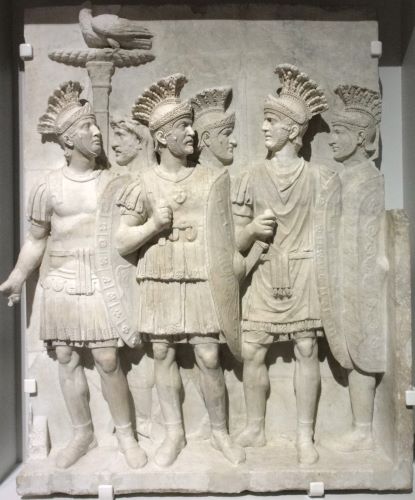
A key legion that stood apart from the rest of the military was the Praetorian Guard, whose major job was defending the emperor himself, followed in priority by the defense of Italy and the city of Rome. The Praetorian Guard started as nine cohorts of 480 men, but later each cohort was grown to 1,000 men. The terms of service in the Praetorian Guard were very attractive: 16 years instead of 25 and pay that was significantly higher (this was a necessity: emperors started with Claudius knew that they were vulnerable to the Praetorians and needed to keep them happy and loyal). Not surprisingly, Praetorians were recruited from veteran legionaries. They did not simply serve the emperor in the city of Rome, instead actively campaigning both when defending Roman territory from invasion (which became an increasing problem by the fourth century CE), and with the emperor while on campaign.
The army was important in integrating provincial subjects into Roman culture. A soldier recruited from the provinces had to learn Latin, at least well enough to take orders and respond to them. Auxiliaries served with men from all over the empire, not just their own home regions, and what each soldier had in common was service to Rome. Commanding officers were often from the Italian heartland, forming a direct link to the Roman center. Military families were a reality everywhere, with sons often becoming soldiers after their fathers. Thus, the experience of serving in the legions or the auxiliaries tended to promote a shared sense of Roman identity, even when soldiers were drawn from areas that had been conquered by Rome in the recent past.
In the provinces, there was a pattern that took place over a few generations. After being conquered by the Romans, there were often resistance movements and rebellions. Those were put down with overwhelming and brutal force, often worse than that of the initial invasion. Eventually, local elites were integrated in the governor’s office and ambitious people made sure their sons learned Latin. Locals started joining the army and, if lucky, returned eventually with money and land to show for it. Roman amenities like aqueducts and baths were built and roads linked the province with the rest of the empire. In short, assimilation happened. A few generations after Roman conquest, many (local elites especially) in a given province would identify with Roman civilization. Regular people in the countryside, meanwhile, would at least be obliged to tolerate Roman rule even if they did not embrace it.
Roman Imperial Society
Rome itself was opulent during this period. The city of Rome boasted eleven aqueducts, enormous structures that brought fresh water into the city from miles away. The houses of the rich had indoor plumbing with drains that led to public sewers. There were enormous libraries and temples, along with numerous public sites for recreation, including public baths, race tracks, and the famous Colosseum, used primarily for displays of lethal gladiatorial combat.
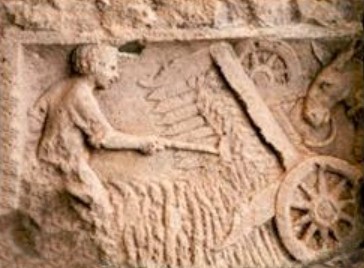
The empire as a whole enjoyed levels of commercial and agricultural productivity not seen again until the seventeenth century CE. Specialized craftsmen made high-quality goods to be sold on an empire-wide market, with better-off citizens enjoying access to quality tools, dishware, linens, and so on, much of which had been manufactured hundreds of miles away. While the long-term economic pattern was that the wealthier parts of society tended to become even richer at the expense of the common people, there was still a substantial “middle class” that enjoyed a relatively high standard of living.
We should note that, while the Romans are not famous as scientists, they are famous as architects and engineers. The Romans used concrete extensively in building projects. They mastered the art of building arches and domes to hold up ceilings without interior supports. Using only gravity, they could transport water dozens of miles, not just in Rome but in other major cities across the Empire. Roman roads were so well built that some survive to the present, now used by cars rather than the horse-drawn carts they were originally built for.
Each city built by the Romans in their conquered territory was laid out according to careful plans, with streets built in grids and centered on a public forum with public buildings. One of the reasons that the Romans were so effective in assimilating conquered peoples into Roman society was that they built a great deal of infrastructure; being conquered by Rome seemed less like a burden when an aqueduct, public baths, and street system appeared within a generation of the Roman conquest (the relative cultural and religious tolerance of Roman culture was also key). All of these cities were linked by the 40,000 miles of roads that stretched across the empire. The primary purpose of these administrative capitals was extracting taxes and other wealth from the local areas and funneling them back to Rome, but they also served as genuine cultural centers. Likewise, even though the roads were often built with troop movement in mind, people everywhere could take advantage of them for trade.
Social Classes
That all being said, there were vast social distances that separated elites and commoners. Even in the city of Rome, most of the citizens lived in squalor, packed into apartment buildings many stories high, made out of flammable wood, looming over open sewers. The rich lived in a state of luxury that probably would not be equaled until the Renaissance, but the majority of Romans lived in squalid conditions.
Most people in the empire were, of course, poor farmers; only a minority of the imperial population lived in cities. Peasants sometimes joined the army, but most were simply poor folk struggling to get by. They were seasonal laborers, they rented from wealthy landowners, or they owned farms but were perpetually threatened by the predatory rich. Over the centuries, poor farmers found it more and more difficult to hold on to their land, both because they could not compete with the enormous, slave-tilled plantations of the rich and because of outright extortion. There are numerous accounts of rich landowners simply forcing small farmers off of land and seizing it; the peasants could not afford to battle the rich in court and the rich had few scruples about hiring thugs to terrify the peasants into submission. Once in a great while, a poorer Roman citizen could petition an emperor personally for redress and succeed, as could the occasional provincial to a governor, but the immense majority of the time the poor (citizen and non-citizen alike) were simply at the mercy of elite landowners.
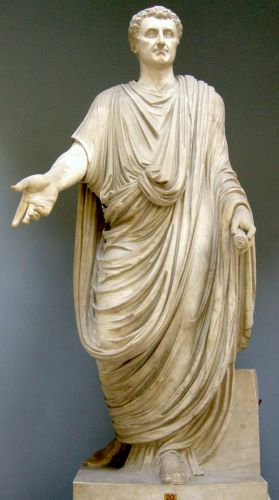
One percent of the population of the empire were members of the aristocracy, those men who were allowed to participate as officials in the imperial government and their families. In turn, access to political power was explicitly linked to wealth, a system first introduced by Augustus himself. To serve in the imperial senate required an annual income of 1,000,000 sesterces (the basic coin of the empire). To serve on the governing council of a small city or town required an annual income of 100,000 sesterces. Meanwhile, a typical soldier earned about 1,200 a year, and poor farmers much less. Land ownership was by far the major determinant of wealth, and with the prevalence of slavery, economies of scale dictated that the more land a given family controlled, the more wealth they could generate.
The overall pattern in the Roman Imperial period is that the wealthy were highly successful in becoming richer from generation to generation, at the expense of the rest of Roman society: the wealth of elite landowners grew approximately eight times from 1 CE to 400 CE, with almost no new wealth coming into the Roman economy during that period. Thus, as a whole, social mobility was so limited as to be almost nonexistent (to cite a single example, a member of the equestrian class in the Empire might have about 17,000 times the annual income of a poor laborer). Roman elites kept taxes on their own property low, but the provinces were often ruthlessly exploited and overall tax levels were high. The immense majority of Roman citizens and subjects were born into the social class they would stay in for their entire lives regardless of their own intelligence and competence.
Still, while they might prey on poor farmers, elite Romans were well aware of the threat posed by destitute city-dwellers. Thus, one striking characteristic of the Imperial period was “bread and circus government.” Building on a precedent originally established by the Gracchi during the Republic, the imperial state distributed free grain (and, later, wine and olive oil) to the male citizens of the city of Rome. Eventually, other Roman cities adopted the practice as well. In addition, public games and theater performances were free, subsidized by the state or by elites showing off their wealth (the most popular were circuses: horse races around a track). Thus, a Roman citizen in one of the large cities could enjoy free bread – although it was not enough to sustain an entire family, necessitating at least some source of supplemental income – and free entertainment. This policy was both a cynical move on the part of the state to keep down urban unrest and a legal right of urban citizens. Free bread or not, the average life expectancy was 45 years for men and 34 for women, the latter because of the horrible conditions of bearing children.
Meanwhile, fully 40% of the population of Italy were slaves when Augustus took power. Not only were slaves captured in war, but children born to slave mothers were automatically slaves as well. Some slaves did domestic labor, but most were part of the massive labor force on huge plantations and in mines. The conditions of life for slaves were often atrocious, and strict oversight and use of violent discipline ensured that no slave revolt ever succeeded (despite the best efforts of leaders of revolts, like Spartacus in the first century BCE). Relatively large numbers of slaves did earn their freedom, and the “freedmen” as a class tended to be innovative commercial entrepreneurs, but many slaves had little hope of freedom. Slavery declined by about 200 CE because supplies started drying up and prices rose; without the constant expansion of the empire, there were far fewer slaves available. By that time, however, the legal and social conditions of farmers had degenerated to the point that they were essentially serfs (known as coloni): unfree rural laborers, barely better than slaves themselves.
Law
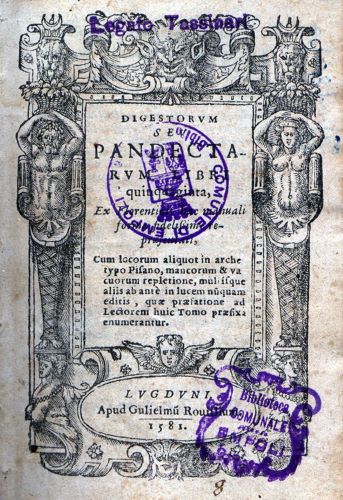
For the republican period and the first few hundred years of the Empire, Roman jurisprudence was split in the provinces. Provincial people were accountable to their own legal systems so long as they were loyal to Rome and paid their taxes on schedule. The most famous historical example of the overlapping legal systems of the Empire was the biblical trial of Jesus before the Roman governor Pontius Pilate. Pilate tried to hand the case off to the local Jewish puppet king, Herod, who in turn refused it and handed Jesus back over to Pilate. In the end, Jesus was executed by the Roman government for inciting rebellion, using the traditional Roman punishment of crucifixion.
Roman citizens could always appeal to Roman law if they wanted to, even if they lived in a province far from Rome. There were many benefits, not least exemption from the local laws that non-citizens were obliged to follow, and wealthy citizens were exempt from the more horrible forms of punishment and execution as well (such as crucifixion). This changed dramatically in 212 CE when the emperor Caracalla extended citizenship to all free men and women (to make it easier to collect taxes). This was an important event because it extended Roman law to almost everyone in the empire.
Some of the concepts and practices of Roman law were to outlive the empire itself. Rome initiated the tradition of using precedent to shape legal decisions, as well as the idea that there is a spirit to laws that is sometimes more important than a literal interpretation. The Romans were the first to codify the idea that someone accused of a crime was innocent until proven guilty; this was a totally radical idea in the area of justice, which in the rest of the ancient world normally held the accused guilty unless guilt could be conclusively disproved.
Much of Roman law still seems grossly unfair from a contemporary perspective. In particular, laws came to establish a formal divide between the rich and the poor, even in the case of citizens. The rich were protected from torture and painful execution, while the poor were subject to both. Slaves were held in such a subservient position by the law that the testimony of a slave was only allowed in court cases if it had been obtained through torture. And, over everything else, the decrees of the emperor were the fundamental basis of law itself; they could not be appealed or contested in the name of some kind of imagined higher authority or written constitution. The emperor was not just about the law, he was the law.
The Late Empire. Christianity, and the Fall
Overview
Rome underwent half a century of crisis in the middle of the third century CE. Beset along its borders and hobbled by constant infighting, the empire was at real risk of collapse for decades. It did not collapse, however, and in fact enjoyed a resurgence of a sort that held the Roman state together until the end of the fifth century (the western half of the Empire “fell” in 476 CE).
In fact, the period between the end of the five good emperors and the collapse of Rome was much more complex than one of simple decline and weakness, and even when the city of Rome could not defend itself, Roman civilization left an enormous, permanent impression on Western Civilization. Perhaps most importantly, what began as an obscure cult in Roman-ruled Judea eventually became one of the great world religions – Christianity – thanks to its success in spreading throughout the Roman Empire before the western Empire’s collapse.
Crisis and Recovery
Major crises affected the Empire from 235 to 284 CE. The basis of the crises was increasing pressure from foreign invaders on the Roman borders coupled with political instability within the Empire itself. The emperor Severus Alexander was murdered in 235 CE. All of the emperors to follow for the next fifty years were murdered or died in battle as well, save one; there were twenty-six emperors in those fifty years, and only one died of natural causes. Many emperors stayed on the throne for only a few months before they were killed. Not surprisingly, in this environment, most emperors were only concerned with either seizing the throne or staying alive once they had it, meaning they tended to neglect everything important to the stability of the Empire.
Rome’s internal political problems were somewhat of its own making – the Praetorian Guard auctioned off the throne, would-be emperors eagerly assassinated their rivals, and Roman elites largely retreated to their enormous estates to profit off of their serfs. Other factors, however, were external: Rome’s international environment grew much worse. In 220 BCE, a new clan – the Sasanians – seized control of Persia. The Sasanians were much more aggressive and well-organized than the earlier Parthian dynasty had been, and Rome was obliged to fight almost constant wars to contain the Persian threat. Simultaneously, the Germanic groups along Rome’s northern borders were growing larger and better-organized. Centuries of contact with Rome itself had improved agricultural techniques among the Germans, leading to population growth. Eventually, these larger, wealthier groups joined together into forces that posed serious threats to the Roman borders.
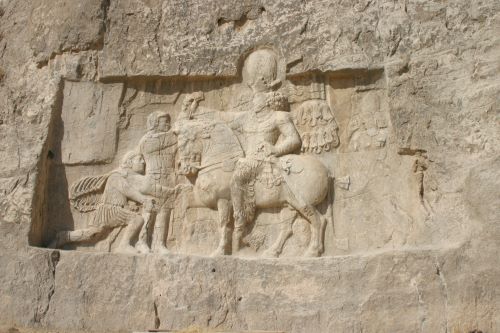
As the quality of Roman leadership declined and the threats grew worse, the results were predictable: Rome lost battles and territory. The emperor Valerian was captured by the Persian king Shapur I when he led a Roman army against Persia and, according to some accounts, was used as the Persian king’s personal footstool for climbing up onto his horse. Another emperor rebuilt walls around Rome itself in 270 CE because of the threat of Germanic invaders from the north, who had pushed all the way into northern Italy. Likewise, emperors, all being generals at this point, traveled constantly with their armies and made their courts wherever they had to while waging campaigns.
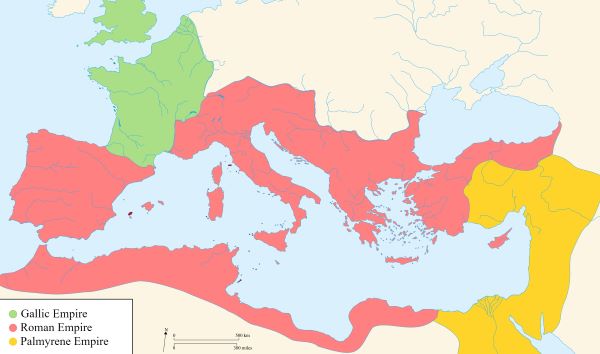
The problem was that the entire Roman imperial system hinged on the direct, personal decision-making of the emperor himself. The emperor was supposed to oversee all major building campaigns, state finances, and the worship of the Roman gods, not just military strategy. Thus, in an era when the speed a message could travel was limited by how fast a messenger could travel on horseback, the machinery of the Roman government ground to a halt whenever the latest emperor was weeks or even months away from Rome. Needless to say, the problem was exacerbated when the Empire was torn between rival claimants to the throne – for a few years toward the end of the crisis period the empire proper was split into three competing “empires”’ under rival imperial pretenders.
Sasanian Persia
Persia was not, of course, simply the most powerful and well organized threat to the Roman Empire. It was an ancient and sophisticated civilization of its own, by the Sasanian period already nearly eight centuries old under the Achaemenids, Seleucids, and Parthians in turn. Drawing on an ancient term for the Persian people, the Sasanians identified their empire as Iranshahr, land of the Iranians, and from this point on it is appropriate to refer to Persia as Iran (this textbook will continue to use the term “Persia” for clarity’s sake, however). Under Sasanian rule, Persia reached the height of its organization, power, and sophistication during the ancient period.
While the Sasanian kings were obliged to govern both settled peoples and nomads, as had all earlier Persian dynasties, they were more successful in creating a stable system of rule, not just relying on their own charismatic authority. For the first time in its history, Zoroastrianism became the official state religion and its holy books were codified, in contrast to the earlier oral traditions of the religion. The state made major efforts to increase both agricultural productivity and the amount of land under cultivation, especially in Mesopotamia. The long-distance trade routes that had grown to such importance under Parthian rule continued to expand in scope and volume of trade, as did crafts and manufacturing in Sasanian territory (Sasanian silk textiles were of such high quality that they were even exported to China itself). The Sasanian rulers drew a direct connection between stability, centralization, and prosperity at precisely the same time that the chaos in Rome undermined the Roman commercial economy.
Sasanian centralization built on the (much earlier) Achaemenid tradition. All rulers were members of the Sasanian family line, and governors of the important provinces were also related to the extended family. Authority was understood to emanate from the Zoroastrian god Ahura Mazda himself, and while a degree of regional autonomy was necessitated by the sheer size and diversity of the empire, regional rulers knew themselves to be inferior to the Sasanian Great King. A powerful institutional relationship between the rulers and the magi (Zoroastrian priesthood) emerged in which Sasanian rule was justified by the direct, unequivocal support of the religious power structure. And, of course, the religious power structure received the approval and support of the royal state in the process, up to and including the only campaigns of religious persecution against non-Zoroastrians in Persian history.
One symptom of the success of the Sasanian state is its longevity in the face of nearly constant challenges: it lasted from the Sasanian seizure of power in 220 CE until it was conquered during the Arab invasions in 651 CE. Rome and Persia did not war constantly, but when they did Persia was obligated to devote enormous resources to containing Roman rapacity (the buffer state of Armenia changed hands a bewildering number of times in the process). Invaders from the Central Asian steppes and the mountains of Afghanistan proved an ongoing security threat to the empire as well, as did the Arab tribes to the southwest well before they unified under the Islamic prophet Muhammad. Nevertheless, and in spite of some significant Roman victories, the Sasanian state remained stable and the economy prosperous for centuries. Likewise, the Sasanian identification of themselves, Iran, and the legacy of previous Persian dynasties fused together the essential ingredients of Persian historical identity. Subsequent dynasties would look back to the Sasanians as the model to emulate, just as the Sasanians had emulated the Achaemenids.
Diocletian
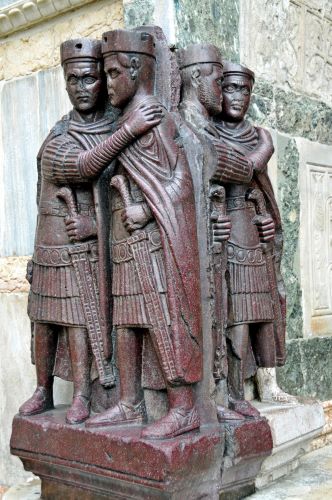
Turning back to Rome, the period of crisis that had made the eastern empire so vulnerable to Persian invasion ended with the ascension of the emperor Diocletian in 284 CE. Diocletian not only managed to survive for twenty years after taking the throne, he also reorganized the empire and pulled it back from the brink. Recognizing that the sheer size of the empire was a detriment to its effective governance, Diocletian decided to share power with a co-emperor: Diocletian ruled the eastern half of the empire and his co-emperor Maximian ruled the west. Then, about ten years after he took the throne, Diocletian decided to further divide responsibility and each emperor took on junior emperor. This created the Tetrarchy, the rule of four. Diocletian further subdivided the empire, so that for the rest of his reign, the four co-emperors (two “augusti” and two “caesars”) worked together to administer the entire territory.
Diocletian’s hope was that the tetrarchy would end the cycle of assassinations. The junior emperors were the senior emperors’ respective heirs, destined to assume full power when their seniors stepped down. When that happened, each new senior emperor would then select new juniors. The overall effect was, if it worked, a neat succession of power instead of the constant bloodshed and uncertainty that had haunted Roman politics for half a century; this system was quite similar to the merit-based selection process of emperors that had held during the rule of the Five Good Emperors.
Diocletian also divided the Empire into smaller provinces so that governors had an easier time with administration. These provinces were grouped into larger units called dioceses overseen by an official called a “vicar.” When Christianity moved from being an illegal cult to the official religion of the empire (see below), the division of imperial territory into dioceses, overseen by vicars, would be adopted by the Catholic Church. That practice persists all the way to the present in the administration of the Church.
To deal with the threat of both Persia and the Germanic tribes, Diocletian reorganized the Roman army and recruited more soldiers, making it larger than it ever had been. He built new roads for military use to be able to move armies along the borders more efficiently. Borrowing from the Persian practice, he emphasized the use of heavy cavalry to respond quickly to threats. Finally, even though the army itself was now larger, he made individual legions smaller, so that each legion’s commander no longer had enough power to take over with a single attack on the current emperor (that worked well enough for Diocletian himself, but it made little difference in the long run).
State finances were in shambles when Diocletian came to power. To try to deal with the problem, Diocletian reformed the tax system and instituted an official census for taxation purposes. He also tried to freeze wages and prices by decree, something that did not work since it created a black market for both goods and labor. Peasants bore the brunt of Diocletian’s reforms; most independent farmers that still existed were turned into serfs (coloni), one step above slaves. State tax collectors were so feared that many peasants willingly gave their land to wealthy landowners who promised to protect them from the tax agents.
Finally, Diocletian tried to reinstate religious orthodoxy. He believed that too many people had turned away from worship of the Roman gods, which had in turn brought about the long period of crisis preceding his takeover. Thus, he went after sects that he thought threatened stability, including Christianity. He banned Christian worship and executed several thousand Christians who refused to renounce their beliefs in an attempt to wipe out the cult once and for all. Needless to say, this was a spectacular failure.
Diocletian retired in 305 CE due to failing health, as did (reluctantly) his co-emperor in the west. The idea behind the Tetrarchy was that the junior emperors would then become the senior emperors and recruit new juniors – this system worked exactly once, as the junior emperors under Diocletian and Maximian took power. Instead of a smooth transition inaugurating a stable new beginning, however, the Empire was yet again plunged into civil war. A general (at the time stationed in Britain) named Constantine, son of the Tetrarch Constantius, launched a military campaign to reunite Rome under his sole rule. By 312 CE he had succeeded, claiming total control and appointing no co-emperor.
Constantine
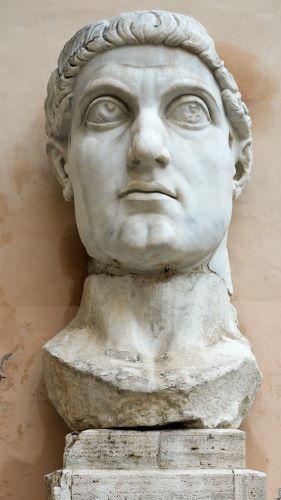
Constantine did away with the system of co-emperors (although it would re-emerge after his death), but otherwise he left things as they had been under Diocletian’s reforms. The eastern and western halves of the Empire still had separate administrations and he kept up the size and organization of the army. He also took a decisive step toward stabilizing the economy by issuing new currency based on a fixed gold standard. The new coin, the solidus, was to be the standard international currency of the western world for 800 years.
Constantine’s greatest historical impact, however, was in the realm of religion. He was the first Christian emperor, something that had an enormous effect on the history of Europe and, ultimately, the world. Before his climactic battle in 312 CE to defeat his last rival to the imperial throne, Constantine had a vision that he claimed was sent by the Christian God, promising him victory if he converted to Christianity. There are plenty of theories about a more cynical explanation for his conversion (most revolving around the fact that Constantine went on to plunder the temples of the old Roman gods), but regardless of the fact that he used his conversion to help himself to the wealth of “pagan” temples, he actively supported Christian institutions and empowered Christian officials. Ultimately, his sponsorship of Christianity saw it expand dramatically in his lifetime.
In 324 CE, Constantine founded a new capital city for the entire empire at the site of the ancient Greek town of Byzantium, at the intersection of Europe and Anatolia (he renamed it “Constantine’s City,” Constantinople, which is today Istanbul). It was at the juncture of the eastern and western halves of the Empire, with all trade routes between Asia and Europe passing through its area of influence. It became the heart of wealth and power in the Empire and a Christian “new beginning” for Roman civilization itself. The city grew to become one of the great cities of late antiquity and the Middle Ages, fed by grain from Egypt and bringing in enormous wealth through trade. Subsequent emperors also built up massive fortifications, walls so strong that it took 1,000 years for an enemy to be able to breach them (namely the Ottoman Turks, who finally conquered the city in 1453 CE).
Religion: Roman Faiths and the Birth of Christianity
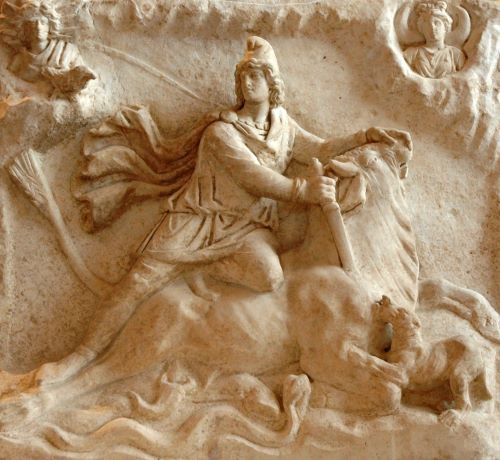
Rome had always been a hotbed of religious diversity. While the official Roman gods were venerated across the Empire, Roman elites had no objections to the worship of other deities, and indeed many Romans (elites and commoners alike) eagerly embraced foreign faiths. Originating in the Hellenistic kingdoms, many Romans were attracted to mystery religions, cults that promised spiritual salvation to their members. These mystery religions shared a belief that the universe was full of magical charms that could lead to spiritual salvation or eternal life itself. In many ways, they were more like cults of magic than traditional religious faiths. A worshiper could join multiple mystery religions, intoning chants and prayers and participating in rituals in hopes of securing good fortune and wealth in life and the possibility of spiritual immortality after death.
Even Rome’s perennial adversary Persia supplied sources of spiritual inspiration to Rome. Mithras, the Zoroastrian god of war, the sun, and rebirth became immensely popular among Romans. Mithrans believed that Mithras had been a soldier, slain by his enemies, who then rose to enjoy eternal life. Roman soldiers campaigning in Persia brought Mithraism back to Rome since Mithras’s identity as a former soldier made his worship all the more appealing to members of the Roman military. The worship of Mithras was so popular that, some historians have noted, it is easy to imagine the Roman Empire becoming Mithran instead of Christian if Constantine had not converted to the latter faith.
In some cases, non-Roman gods even came to supplant Roman ones; one of the Severan emperors embraced the worship of the Syrian sun god Sol Invictus (meaning “the unconquered sun”) and had a temple built in Rome to honor the god alongside the traditional Roman deities. The notion of being as powerful and unstoppable as the sun appealed to future emperors, so subsequent emperors tended to venerate Sol Invictus along with the Roman Jupiter until the triumph of Christianity. In other cases, the worship of non-Roman gods was so popular that it simply could not be suppressed in the few cases in which Roman leaders saw a need to. The Egyptian goddess Isis, who was at the heart of the largest mystery cult in the entire Mediterranean region, was so popular among both women and men that repeated attempts to purge her cult from Rome for being socially disruptive utterly failed.
The Jews and Jesus
The Roman territory of Palestine was a thorn in Rome’s side thanks to the unshakable opposition of the Jews. Palestine suffered from heavy taxation and deeply-felt resentment toward the Romans. One key point of contention was that the Jews refused to pay lip service to the divinity of the emperors. The Romans insisted that their subjects participate in symbolic rituals acknowledging the primacy of the emperors, but since the Jews were strict monotheists, they would not do so.
In 66 CE there was a huge uprising against Rome. It took four years for imperial forces to crush the uprising, resulting in the greatest disaster in ancient Jewish history: the permanent destruction of the Temple of Jerusalem in 70 CE. In the aftermath, the Romans enslaved or deported much of the Jewish population, which contributed to the phenomenon of the Jewish diaspora, the people without a homeland united only by the Hebrew Bible, the teaching of the rabbis, and Jewish cultural traditions. Another uprising decades later (between 132 – 136 CE) resulted in the almost complete dispersal of the Jews, to the point that the Jewish homeland was truly lost to them until the foundation of the modern state of Israel in 1948 CE.
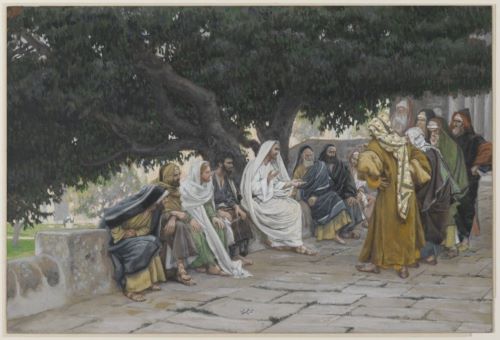
In the first century CE, Jewish society, especially its leadership, was divided between rival groups. Some powerful priests, the Sadducees, claimed that all Jews should follow the 10 Commandments, but only the priests of the Temple needed to follow the 613 laws and injunctions laid down by Moses. They were opposed by the Pharisees, who insisted that all Jews had to abide by all of the laws of Moses, and they also preached that a messiah – a savior – would soon come to bring about a day of judgment before Yahweh and bring about the fulfillment of the Biblical Covenant. In the deserts outside of the major cities, a group called the Essenes emphasized a life of asceticism and mysticism, while across Palestine anti-Roman revolutionaries known as the Zealots advocated for armed revolt against the Roman occupier.
The Jewish uprising that occurred against the Romans in 66 CE happened a generation after the death of another Jewish revolutionary of sorts: Jesus of Nazareth. The major source of information on the life of Jesus are the four Gospels, accounts of his life and teachings composed after his death by three of his apostles (his closest followers and students), Matthew, Mark, and John, and another early Christian leader, Luke. The Gospels were transmitted orally for decades before being recorded in their definitive versions; most scholars now date the written gospels to approximately 90 CE (about sixty years after the death of Jesus). While the specific language of the Gospels is, of course, different, and some of the events described are also described differently, the Gospels agree on most of the major aspects of the life of Jesus.
According to the Gospels, Jesus was the son of the miraculous union of the Holy Spirit, one of the aspects of the Jewish God Yahweh, and a virgin named Mary. Jesus showed an aptitude for theological and spiritual understanding at a young age, debating Jewish doctrine with learned Jewish priests when he was still a boy. At the age of thirty, having earned his living as a carpenter up to that point, Jesus began to preach a message of salvation that revolved around the concept that mankind as a whole could be saved if it sought forgiveness from God for its sins. He traveled and delivered his teachings in the Roman province of Palestine and the nearby puppet kingdoms dominated by the Romans for three years, but was then arrested by the Roman authorities for inciting rebellion. In the end, Jesus was executed in the customary Roman fashion of crucifixion at the age of 33.
According to the Gospels, Jesus returned to life, with an angel rolling the boulder back from the entrance to the tomb in which his body had been laid to rest. He renewed his call for devotion to God and the offer of salvation for those who sought forgiveness, then passed into the divine presence. Jesus’s followers, led by the twelve apostles, began to teach his lessons to others, and the new religion of Christianity was born. His followers began to refer to Jesus as “the Christ,” meaning “the anointed one” in Greek, a reference to the idea that Jesus was anointed to provide salvation for humanity.
Early Christianity
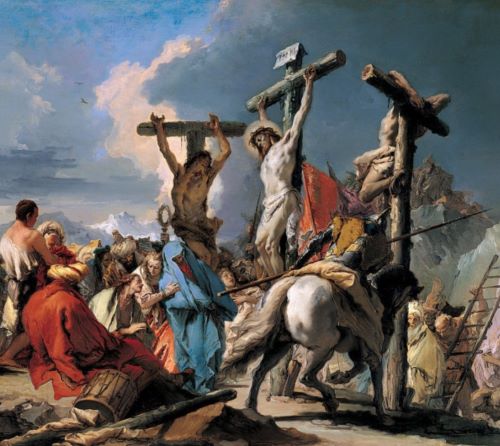
At the beginning of the Christian faith, there was no single set of texts or beliefs that united Christians. The four major Gospels do not agree on everything, because they were written by different people from memory (decades after the apostles themselves were alive). It was St. Paul, a Jewish leader who underwent a profound conversion experience and became the foremost Christian evangelist, who popularized the notion that the death of Jesus on the cross was part of a divine plan that canceled out human sin. For hundreds of years, Christians debated and argued about what Christ’s message had “really” been because many of Jesus’s teachings were, and are, open to interpretation. Early Christians were divided on very significant issues, including:
What God did Jesus represent? One cult believed that the God of Christ was not the Jewish God, who had been vengeful and warlike. According to this sect, Christ’s God was a more powerful and loving deity come to save the world from Yahweh.
Was Jesus the messiah? In Jewish doctrine, the messiah was to be a figure who liberated the Jews from oppression and made good on the Covenant between the Jews and God, delivering the Promised Land for all eternity. Many Jews had hoped that Jesus would be a revolutionary against Roman rule and, since Judea remained in Roman hands after his death, they did not believe that Jesus had been the messiah. Early Christians came to insist, following Paul, that Jesus had indeed been the messiah, but that the “liberation” he offered was spiritual in nature, rather than having to do with prosaic politics. In other words, the potential to save one’s soul from damnation superseded the old Covenant.
Was Jesus human, or was he instead somehow God Himself? He lived like a normal man, but according to the gospels he had also performed miracles, and he claimed to be the son of God. Likewise, while Jesus lived an exemplary life, he also displayed traits like anger and doubt (the latter most famously on the cross when he asked God why He had “forsaken” Jesus), traits that did not seem those of a “perfect” being. This debate would go on for centuries, with equally pious groups of Christians coming to completely different conclusions about Christ’s divine and human natures.
Likewise, early Christians were torn as to whether everyone could be a Christian, or instead, if membership was limited to the Jews. If Jesus was indeed the specifically Jewish messiah, after all, it did not make sense for a Roman or a Persian or a Celt to be able to convert. In the end, thanks largely to the influence of St. Paul again, most Christians came to believe that the salvation offered by Christ was potentially universal, and that not just Jews could become Christians as a result.
Under the influence of the mystery religions noted above, many early Christians were Gnostics, meaning “those who know” in Greek. The Gnostics believed that Jesus had been a secret-teller, almost a magician, who provided clues in his life and teachings about how to achieve union with God. This had more to do with magic than with a recognizable set of religious rituals or customs – for example, many Gnostics believed that it was possible to deduce a series of incantations from Christ’s teachings that included hundreds of secret “names of God.” If a Gnostic was to properly chant all of the names of God, he would not only achieve salvation but might enjoy power on earth, as well. The Gnostics had no interest in converting people to their version of Christianity; it was a secret they wanted to keep for themselves.
Still, despite the bewildering diversity of beliefs among early Christians, there were common themes, most importantly the emphasis Jesus Himself had placed on the spiritual needs of the common people, even social outcasts. The most radical aspect of Christianity was its universalism. From Judaism, it inherited the idea that all human beings are spiritually equal. Once the debate about whether non-Jews could become Christians was resolved, it was also potentially open to anyone who heard Christianity’s teachings and doctrine. Early Christians recognized no social distinctions, which was fundamentally at odds with the entire Roman system, reliant as it was on formal legal separations between social classes and a stark system of social hierarchy. Likewise, one unequivocal requirement placed on Christians was to love their neighbors, meaning in practice showing kindness and compassion to others regardless of their social rank. Few concepts could have been more alien to Roman sensibilities.
Christianity thus at least potentially threatened the hierarchical nature of Roman society. Likewise, it inherited from Judaism a strict monotheism that refused to accept the worship of the Roman emperors. What made it even more threatening than Judaism, however, was that Christianity actively sought out new converts (i.e. Christianity was inherently evangelical, in stark contrast to Judaism which did not seek new members). Roman authorities were thus already very much inclined to be suspicious of the Christians as potential rabble-rousers. In 68 CE, Nero blamed the Christians for the huge fire that consumed much of the city of Rome, and hundreds of Christian were rounded up and slaughtered in the arena. The persecution of Christians became a potent symbol for Christianity as a whole. Over a thousand years later, when Christianity was firmly entrenched as the religion of Europe, the trope of martyrdom was still used to explain righteous suffering.
Early Christian Organization
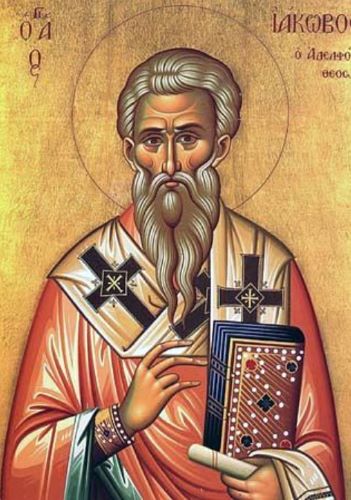
Before Constantine’s conversion, Christianity expanded through missionary work, which succeeded in founding congregations across the Empire but did not seriously disrupt polytheism or the Empire’s religious diversity. Imperial sponsorship changed that because it linked secular power to Christian identity. Following Constantine’s conversion, being a Christian became a way to get ahead in the Roman power structure, and over time it became a liability to remain a polytheist. Thus, whereas early Christianity had been a religion of the common people, Roman elites flocked to convert after Constantine did so in order to stay in the emperor’s good graces.
Early Christians had already developed a distinct hierarchy of worshipers, a divide between priests and worshipers. Bishops were the head of each city’s congregation, and they supervised a staff of priests and deacons who interacted with everyday worshipers and led services. The bishops of main cities, usually the imperial capitals of their respective provinces, came to be called an archbishop. Each bishop oversaw activity in the diocese, again following the imperial structure, in instructing people in Christian doctrine and in building charity networks. One important effect was that the church actively supported charities for the poor and hungry, a practice which won over new converts. This was one of the notable moments in history when a religion linked together a message of compassion for the needy and real, practical efforts to help the needy. In another strong contrast with Roman practice, Christianity saw disenfranchised groups like women and the poor (not to mention poor women) play major roles in the church’s organization, especially before “official” Christianity came into being under Constantine.
Almost immediately after Constantine became a Christian, bishops saw their secular power increase dramatically. He allowed bishops to serve as official judges, giving Christians the ability to request a bishop instead of a non-Christian judge in trial. Bishops also moved in administrative circles, representing not just the church but their cities in actions and requests before governors and assemblies. In short, bishops suddenly assumed power on par with that of the traditional Roman nobility, directly linking power within the Christian church hierarchy to power within the Roman political system.
The most important bishop was the archbishop of Rome, who for the first few centuries of Christianity was just one among several major church leaders. Originally, the archbishops of cities like Alexandria and Damascus were of comparable importance to the Roman archbishop, but over time Roman archbishops tried to assert authority over the entire church hierarchy in the west. Their authority, however, was not recognized in much of the eastern part of the Empire, and it should be emphasized that it took more than six centuries after Constantine for the Roman archbishop’s authority to receive acceptance even in the west. Eventually, however, that authority was at least nominally in place, and the Roman archbishop came to be known as the “pope,” meaning simply “father,” of the church.
The pope’s role as leader of the church emerged for a few reasons. First and foremost, the symbolic power of the city of Rome itself gave added weight to the Roman archbishop’s authority. Second, there was a doctrinal tie to the Apostle Peter, who was supposed to have been given the symbolic keys to heaven directly from Christ, which were in turn passed on to his successor in Rome (the archbishop of Rome) before being crucified. Roman archbishops could thus argue that the Christian church itself was centered in Rome, and that they inherited the spiritual keys to heaven upon taking office – this concept was known as the “Petrine Succession.” By the mid-fifth century CE, the popes were claiming to have total authority over all other bishops, and at least some of those bishops (in Western Europe, at any rate) did look to Rome for guidance. In later centuries, the mere fact that the early popes had claimed that authority, and certain bishops had acknowledged it, was cited as “proof” that the Roman papacy had always been the supreme doctrinal power in the Church as a whole.
Christianity’s Relationship with Non-Christian Religions
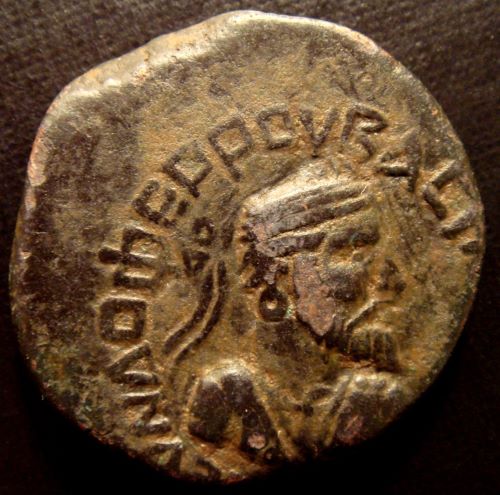
All across the Empire, massive church buildings were erected by emperors. Right from the beginning of “official” Christianity, Constantine financed construction of huge churches, including the Basilica of St. Peter in what is today the Vatican (at the time it was an obscure graveyard in Rome). The traditional Roman public buildings, including forums, theaters, bathhouses and so on, were often neglected in favor of churches, and many temples to Roman gods and other public buildings were repurposed as churches.
Once it enjoyed the support of the Roman elite, the Christian church began incorporating non-Christian holidays into its own liturgical calendar. December 25 had been the major festival of the sun god Sol Invictus, and early Christians embraced the overlap between that celebration and Christmas, noting that Christ was like the sun as a source of spiritual life. Other Christian holidays like Easter coincided with various fertility festivals that took place in early spring, around the time of the spring equinox. The tradition of saint’s days, holidays celebrated in veneration of specific saints, often overlapped with various non-Christian celebrations. Most church leaders saw no theological problem with this practice, arguing that the ultimate goal was the salvation of souls through conversion, so it made perfect sense to use existing holy days and rituals in order to ease the transition for new converts.
That being noted, the incorporation of non-Christian celebrations into the liturgical calendar did not imply that Christians were willing to accept polytheism. Unlike most ancient faiths, Christians could not tolerate the worship of other gods, which they regarded as nothing more than nonexistent delusions that endangered souls. They used the term “pagan,” coming from the Latin paganus, which means “country bumpkin” or “redneck,” to describe all worshipers of all other gods, even gods that had been worshiped for thousands of years at that point. Christians thus used scorn and contempt to vilify worshipers of other gods – “pagan” indicated that the non-Christian was both ignorant and foolish, even if he or she was a member of the Roman elite.
It took about a century for the believers in the old Roman gods, especially the conservative aristocracy of Rome, to give up the fight. As money shifted toward building Christian churches and away from temples, so did Christians sometimes lead attacks to desecrate the sites of pagan worship. Riots occasionally broke out as Christian mobs attacked worshipers of other gods, all with the tacit support of the emperors. In 380 CE the Empire was officially declared to be Christian by the emperor Theodosius I and all people of importance had to be, at least nominally, Christians. There was no sustained resistance to Christianity simply because “polytheism” or “paganism” was never a unified system, and it was impossible for people who worshiped a whole range of gods to come together “against” Christianity, especially when it was the official religion of the Empire itself.
A much more difficult battle, one that it some ways was never really won, had to do with “pagan” practices. Everyone in the ancient world, Christians among them, believed in the existence of what is now thought of as “magic” and “spirits.” Christian leaders came to believe that, in general, magic was dangerous, generated by the meddling of the devil, and that the spirits found in nature were almost certainly demons in disguise. There was very little they could do, however, to overturn the entire worldview of their followers, considering that even Christian leaders themselves very much believed that spirits and magic were present in the world, demonic or not. Thus, pagan practices like blessing someone after they sneezed (to keep out an invading spirit or demon), throwing salt over one’s shoulder to ward off the devil, and employing all manner of charms to increase luck were to survive to the present.
Orthodoxy and Heresy
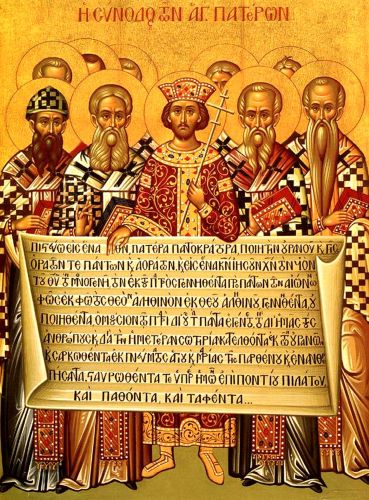
Christianity united self-understood “Western Civilization” just as Roman culture had a few centuries earlier. At the same time, because of the peculiarities of Christian belief, it was also a potentially divisive force. Christians spoke a host of different languages and lived across the entire expanse of the Empire. As noted above, there were serious debates around who or what Jesus was. For centuries, there could be no “orthodoxy,” meaning “correct belief,” because there was no authority within the church (very much including the popes) who could enforce a certain set of beliefs over rival interpretations.
The beginning of orthodoxy was in the second and third centuries, when a group of theologians argued that there were three personas or states of the divine being, referred to as the Holy Trinity. In this view, God could exist simultaneously as three beings: God the Father, the being that spoke in the Old Testament, God the Son, Jesus himself, and God the Holy Spirit, the presence of God throughout the universe. This concept did not quell controversy at all, though, because it created a distinct stance that people could disagree with – rival groups of Christians came to refer to their enemies as “heretics,” from the word “heresy,” meaning simply “choice.”
In the late third century, an Egyptian Christian priest named Arius created a firestorm of controversy when he made a simple logical argument: God the father had created Jesus, so it did not make any sense for Jesus to be the same thing as God. Furthermore, it was impossible to be both human and perfect; since Jesus was human, he was imperfect and could not therefore be God, who was perfect. This belief came to be known as “Arianism” (note that the word has nothing whatsoever to do with the misguided belief in some kind of ancient Germanic race – the “Aryans” – so important to Nazi ideology almost two thousand years later). Arianism quickly took hold among many people, most importantly among the Germanic tribes of the north, where Arian Christian missionaries made major inroads. Thus, Arianism quickly became the largest and most persistent heresy in the early Christian church.
In 325 CE, only a little over a decade after he had converted to Christianity, Constantine assembled a council of church leaders, the Council of Nicaea, to lay Arianism to rest. One of the results was the Nicene Creed (now usually referred to as the Apostles’ Creed), to this day one of the central elements of Catholic Mass. In a single passage short enough to commit to memory, the Creed declared belief in Christ’s identity as part of God (“consubstantial to the Father” in its present English translation), Christ’s status as the son of God and the Virgin Mary, Christ’s resurrection, and the promise of Christ’s return at the end of the world. There was now the first “party line” in the early history of Christianity: a specific set of beliefs backed by institutional authority.
While united in belief, Christians were divided by language, since the western Empire still spoke Latin and the eastern Empire Greek. In 410 the monk Jerome produced a version of the Christian Bible in Latin, the Vulgate, which was to be the main edition in Europe until the sixteenth century. Surprising from a contemporary perspective, however, is that it was not until 1442 (during the Renaissance) that the definitive and in a sense “final” version of the Bible was established by the Western Church when it defined exactly which books of the Old Testament were to be included and which were not.
Meanwhile, in the east, Greek was not only the language of daily life for many, it was the official language of state in the Empire and the language of the church. The books of the New Testament, starting with the Gospels, were written in Greek in the first place, and the Greek intellectual legacy was still very strong. There was an equally strong Jewish intellectual legacy that provided accurate translations from Hebrew and Aramaic to Greek, providing Greek-speaking Christians with access to a reliable version of the Old Testament.
While it certainly clarified the beliefs of the most powerful branch of the institutional church, as the Council of Nicaea defined the official orthodoxy, it guaranteed that there would always be those who rejected that orthodoxy in the name of a different theological interpretation. Likewise, the practical issues of lingual and cultural differences undermined the universalism (“Catholicism”) of the Christian Church. Those differences and the diversity of belief would only grow over time.
Monasticism and Christian Culture
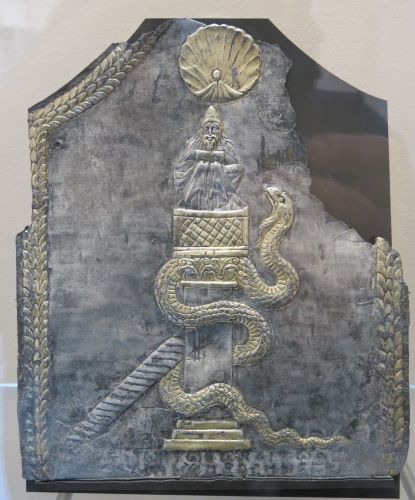
Near the end of the third century, a new Christian movement emerged that was to have major ramifications for the history of the Christian world: monasticism. Originally, monasticism was tied to asceticism, meaning self-denial, following the example of an Egyptian holy man named Antony. In about 280, Antony sold his goods and retreated to the desert to contemplate the divine, eschewing all worldly goods in imitation of the poverty of Christ. He would have remained in obscurity except for a book about him written by the bishop Athanasius, The Life of Antony, that celebrated Antony’s rejection of the material world and embrace of divine contemplation. According to Athanasius, normal life was full of temptation, greed, and sin, and that the holiest life was thus one that rejected it completely in favor of prayer and meditation away from human company. Thousands of people followed Antony’s example, retreating to the wilderness. These early monks were called Anchorites: hermits who lived in deserts, forests, or mountains away from the temptations of a normal social existence (although they had to live close enough to civilization for the donations of food that kept them alive).
One particularly extreme sect of early monks were the Stylites, from the Greek word stylos, meaning “column.” The founder of the group, St. Simeon the Stylite, climbed up a pillar in Syria and spent the next 30 years living on top of it. He was so famous for his holiness and endurance in the face of the obvious physical toll of living on top of a pillar that he attracted followers from all over the Roman world who came to listen to him preach. Soon, many others sought out columns in imitation of Simeon.
Ultimately, pillar-sitting did not become the predominant model of Christian life. Instead, groups of ascetics came together in communities called monasteries. Originally, these early monks spent almost all of their time in prayer, but over time most monastic communities came to embrace useful work as well as prayer and meditation. The most important development in the development of monasticism was the work of Benedict, an Italian bishop, who wrote a book known as the Rule in about 529 that laid out how monks should live. The Rule dictated a strict schedule for daily life that revolved around prayer, study, and useful work for the monastery itself (tending crops and animals, performing labor around the monastery, and so on). Going forward, many monasteries became economic powerhouses, owning large tracts of land and selling their products at a healthy profit.
More important than their economic productivity, at least from the perspective of the history of ideas, is that monasteries became the major centers of learning, especially in Western Europe after the collapse of the western Roman Empire. One of the tasks undertaken by monks was the painstaking hand-copying of books, almost all of which had to do with Christian theology (e.g. the Bible itself, commentaries from important Christian leaders, etc.), but some of which were classical Greek or Roman writings that would have otherwise been lost. Often, these books were beautifully illustrated by the monks and are referred to as illuminated manuscripts – among the finest examples of medieval art.
Outside of monasteries, churches were built in practically every city and town (and many small villages) in the Roman sphere of influence. One interesting and, from a contemporary perspective, somewhat peculiar phenomenon in early Christianity was the focus on relics: holy objects. Relics were everything from the bones of saints to fragments of the “True Cross” on which Christ was crucified. Each church had to have a relic in its altar (contained in a special box called a reliquary) or it was not considered to be truly holy ground. All relics were not created equal: the larger the object, or the closer it had been to Christ or the apostles, the more holy power it was believed to contain. Thus, a thriving trade in relics (plagued by counterfeits – it was not easy to determine if a given finger bone was really the finger bone of St. Mark!) developed in Europe as rival church leaders tried to secure the most powerful relic for their church. This was not just about the symbolic importance of the relics, as pilgrims would travel from all over the Roman world to visit the site of noteworthy relics, bringing with them considerable wealth. Whole regional economies centered on pilgrimage sites as a result.
Christian Learning
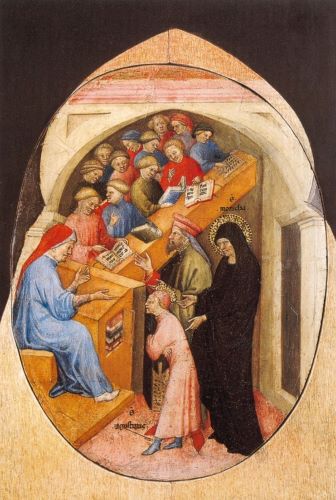
Christian learning was a complex issue, because, strictly speaking, spiritual salvation was thought to be available to anyone simply by accepting the basic tenets of Christian doctrine. In other words, the whole intellectual world of Greek and Roman philosophy, literature, science, and so on did not necessarily relate to the Church’s primary task of saving souls. Many church leaders were learned men and women, however, and insisted that there was indeed a place for learning within Christianity. The issue was never settled – one powerful church leader, Tertullian, once wrote “what does Athens have to do with Rome?”, meaning, why should anyone study the Greek intellectual legacy when it was produced by pre-Christian pagans?
Once Christianity was institutionalized, church leaders generally came around to the importance of classical learning because it proved useful for administration. A vast Greco-Roman literature existed describing governance, science, engineering, etc., all of which was necessary in the newly-Christian Empire. A kind of uneasy balance was struck between studying classical learning, especially things like rhetoric, while warning against the spiritual danger of being seduced by its non-Christian messages.
The most important thinker who addressed the intersection of Christian and classical learning was St. Augustine of Hippo (a Roman city in North Africa), whose life spanned the late fourth and early fifth centuries. Augustine lived through the worst period of Roman decline, completing his work while his own city was besieged by a Germanic group called the Vandals. To Roman Christians, this posed a huge challenge – if all-powerful God had embraced them, why was their empire falling apart? Augustine’s answer was that life on earth is not ultimately significant. In his work The City of God, Augustine distinguished between the perfect world of heaven, attainable through Christian faith, versus the flawed and imperfect world of the living. This concept explained the decline of the Empire as being irrelevant to the greater mission of salvation. Thus, according to Augustine, all of learning was just a facet of material life; useful in its way but totally insignificant compared to the necessity of laying one’s soul bare to God and waiting for the second coming of Christ.
The irony of these struggles over Christian doctrine versus ancient learning was that the issue was decided by the collapse of Rome. When Rome fell to Germanic invaders in the mid-fifth century, so began the decline of organized learning – there simply was no funding from Roman elites for what had been a robust private school system. In the absence of instruction, literature and philosophy and engineering all but vanished, preserved only in monasteries and in the eastern Empire. Once the western Empire collapsed, the church was the only institution that still supported scholarship (including basic literacy), but over time the levels of literacy and education in Europe unquestionably declined. This decline inspired the contempt of later Renaissance thinkers who wrote off the period between the fall of Rome and the beginning of the Renaissance in about 1300 CE as the “Dark Ages.”
Ultimately, after the western part of the Roman Empire fell in the late fifth century, it was the Christian Church that carried on at least parts of Roman civilization, learning, and culture. One of the historical ironies of this period of history is that even though Rome’s Empire began to decline and (eventually) collapse politically, it lived on thanks to ideas and beliefs that originally arisen in the Roman context – it lived on ideologically and spiritually.
The Fall of Rome
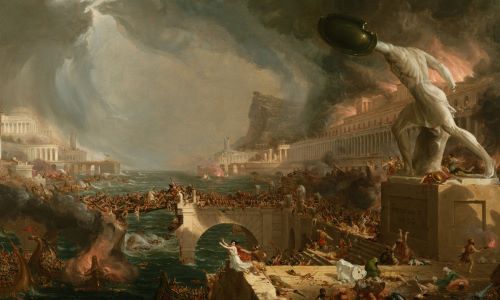
The fall of Rome, conventionally dated to 476 CE, is one of the most iconic events in the history of the western world. For centuries, people have tried to draw lessons from Rome’s decline and fall about their own societies, a practice inspired by the question of how so mighty and, at one time, stable a civilization could so utterly disintegrate. The answers have varied considerably: Rome grew corrupt and weak over time, Rome was infiltrated by “barbarian” cultures, Rome was simply overcome by overwhelming odds, or perhaps Rome was simply transformed into a different, more diverse set of societies rather than destroyed in so many words. However the events of the period are interpreted, the simple fact remains: the political unity of the Roman Empire was shattered by the end of the fifth century CE.
While the debate as to the causes of Rome’s fall will probably never be definitively answered, an important caveat should be noted: Rome did not “really” fall for another thousand years, even though the city of Rome itself, along with the western half of the Empire, did indeed lose its sovereignty in the face of invasion by Germanic “barbarians.” The Roman capital had already been moved to Constantinople in the early fourth century, and the eastern half of the empire remained intact, albeit under constant military pressure, until 1453. Arguably, one of the major causes for the collapse of the western empire was the fact that the Empire as a whole had focused its resources in the east for a century by the time waves of invaders appeared on the horizon starting in the fourth century CE.
At the time, most Christians blamed polytheism and heresy for Rome’s fall: it was God’s wrath exacted on a sinful society. In turn, the remaining polytheists blamed Christians for undermining the worship of the gods who had presided over the Empire while Rome was great.
From the contemporary perspective, Rome’s fall seems to have less to do with divine intervention than routine defeats and growing threats.
A note on nomenclature: this section will refer to the groups responsible for the destruction of the western empire as barbarians when referring to the Roman perception of Germanic and Central Asian groups. The point is not to vilify those groups, but to emphasize the degree to which Romans were both contemptuous towards and, it turns out, vulnerable to them. When possible, it will refer to specific groups by name such as the Goths and the Huns. In addition, it will refer to “Germans” when discussing the specific groups native to Central Europe that played such a key role in the fall of Rome. That is something of a misnomer, however, since there was no kingdom or empire called “Germany” until 1871 CE (i.e. about 1,400 years later). Thus, when using the term “Germans,” this section is referring to any of the Germanic cultural groups of the era rather than the citizens or subjects of a unified country.
Roman Relations with Barbarians
Romans had always held “barbarians” in contempt, and they believed that the lands held by barbarians (such as Scotland and Germany) were largely unsuitable for civilization, being too cold and wet for the kind of Mediterranean agriculture Romans were accustomed to. Romans believed that barbarian peoples like the Germans were inferior to subject peoples like the Celts, who could at least be made useful subjects (and, later, citizens) of the Empire. For the entire history of the Empire, the Romans never seem to have figured out exactly which groups they were interacting with; they would simply lump them together as “Goths” or even “Scythians,” a blanket term referring to steppe peoples. Occasionally, hundreds of years after they “should have known better,” Roman writers would actually refer to Germans as Celts.
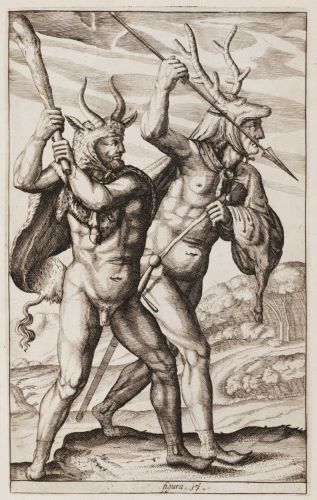
It is easy to overstate this attitude; there were many members of Germanic tribes who did rise to prominence in Rome (one, Stilicho, was one of the greatest Roman generals in the late Empire, and he was half Vandal by birth). Likewise, it is clear from archaeology that many Germans made a career of fighting in the Roman armies and then returning to their native areas, and that many Germans looked up to Rome as a model of civilization to be emulated, not some kind of permanent enemy. Some Romans clearly did admire things about certain barbarian groups, as well – the great Roman historian Tacitus, in his Germania, even praised the Germans for their vigor and honor, although he did so in order to contrast the Germans with what he regarded as his own corrupt and immoral Roman society.
That said, it is clear that the overall pattern of contact between Rome and Germania was a combination of peaceful coexistence punctuated by many occasions of extreme violence. Various tribes would raid Roman lands, usually resulting in brutal Roman reprisals. As the centuries went on, Rome came increasingly to rely on both Germanic troops and on playing allied tribes off against hostile ones. In fact, by the late fourth century CE, many (sometimes even most) soldiers in “Roman” armies in the western half of the Empire were recruited from Germanic groups.
The only place worthy of Roman recognition as another “true” civilization was Persia. When Rome was forced to cede territory to Persia in 363 CE after a series of military defeats, Roman writers were aghast because the loss of territory represented “abandoning” it to the other civilization and state. When “barbarians” seized territory, however, it rarely warranted any mention among Roman writers, since it was assumed that the territory could and would be reclaimed whenever it was convenient for Rome.
Meanwhile, there had been hundreds of years of on-again, off-again wars along the Roman borders before the “fall” of Rome actually occurred. Especially since the third century, major conflicts were an ongoing reality of the enormous borders along the Rhine and Danube. Those conflicts had prompted emperors to build the system of limes meant to defend Roman territory, and from that point on, the majority of Roman legions were usually deployed along the semi-fortified northern borders of the empire. There is evidence that many of those soldiers spent their careers as not-so-glorified border guards and administrators and never experienced battle itself; there is no question that the performance of the Roman military was far poorer in the late imperial period than it had been, for instance, under the Republic.
In turn, many of the Germans who settled along those borders were known as federatii, tribal groups who entered into treaties with Rome that required them to pay taxes in kind (i.e. in crops, animals, and other forms of wealth rather than currency) and send troops to aid Roman conquests, and who received peace and recognition (and usually annual gifts) in return. The problem for Rome was that most Germanic peoples regarded treaties as being something that only lasted as long as the emperor who had authorized the treaty lived; on his death, there would often be an incursion since the old peace terms no longer held. The first task new emperors had to attend to was often suppressing the latest invasion from the north. One example was the Goths, settled at the time somewhere around present-day Romania, whom Constantine severely punished after they turned on his forces during his war of conquest leading up to 312 CE.
The bottom line is that, as of the late fourth century CE, it seemed like “business as usual” to most political and military elites in the Roman Empire. The borders were teeming with barbarians, but they had always been teeming with barbarians. Rome traded with them, enlisted them as soldiers, and fought them off or punished them as Roman leaders thought it necessary. No one in Rome seemed to think that this state of affairs would ever change. What contemporary historians have determined, however, is that things had changed: there were more Germans than ever before, they were better-organized, and they were capable of defeating large Roman forces. What followed was a kind of “barbarian domino effect” that ultimately broke the western Empire into pieces and ended Roman power over it.
One other factor in the collapse of the western half of the Empire should be emphasized: once Rome began to lose large territories in the west, tax revenues shrunk to a fraction of what they had been. While the east remained intact, with taxes going to pay for a robust military which successfully defended Roman sovereignty, Roman armies in the west were under-funded, under-manned, and vulnerable. There was thus a vicious cycle of lost land, lost revenue, and poor military performance that saw Roman power simply disintegrate over the course of less than a century. Even the handful of effective emperors and generals in the west during that period could not staunch the tide of defeat.
Invasions
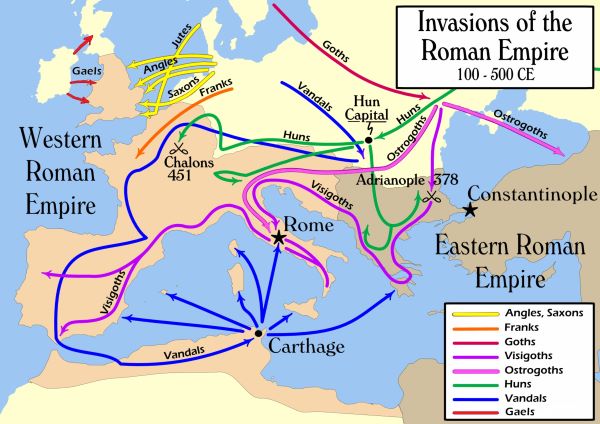
The beginning of the end for the western empire was the Huns. The Huns were warriors of the central Asian steppes: expert horsemen, skillful warriors, unattached to any particular land. They had much in common with other groups of steppe peoples like the Scythians who had raided civilized lands going back to the very emergence of civilization in Mesopotamia. They were believed to be so cruel and so unstoppable that the Germanic groups farther west claimed that they were the product of unions between demons and witches, rather than normal humans.
In 376 the Huns drove a tribe of Goths from their lands in southern Russia. Those Goths were allowed to settle in the Balkans by the Romans, but were soon extorted by Roman officials, causing the Goths to rise up against Rome in retribution. In 378 the Goths killed the emperor, Valens, and destroyed a Roman army in an open battle. The new emperor made a deal with the Goths, allowing them to serve in the Roman army under their own commanders in return for payment. This proved disastrous for Rome in the long run as the Goths, under their king Alaric, started looting Roman territory in the Balkans, finally marching into Italy itself and sacking Rome in 410 CE. The Roman government officially moved to the city of Ravenna in the north (which was more defensible) following this sack.
The Gothic attack on Rome was the first time in roughly seven hundred years that the walls of Rome had been breached by non-Romans. The entire Roman world was shocked and horrified that mere barbarians could have overwhelmed Roman armies and struck at the heart of the ancient Empire itself. Rome’s impregnability was itself one of the founding stories Romans told themselves; Romans had long vowed that the Celtic sack of 387 BCE would be the last, and yet the Goths had shattered that myth. With the benefit of historical hindsight, we can see the arrival of the Huns as the beginning of a “domino effect” in which various groups were pushed into Roman territory, with the sack of Rome merely one disaster of many for the Empire.
Leading up to that event, the Roman legions were already losing their former coherence and unity. In 406 CE a very cold winter froze the Rhine river, and armies of barbarians invaded (literally walking across the frozen river in some cases), bypassing the traditional Roman defenses. One group, the Vandals, sacked its way to the Roman provinces of Spain and seized a large swath of territory there. The entire army of Britain left in 407 CE, when yet another ambitious general tried to seize the imperial throne, and Roman power there swiftly collapsed.
Roman armies from the western empire hastily marched back to Italy to fight the Goths, abandoning their traditional defensive posts. For the next fifty years, various groups of Germanic invaders wandered across Europe, both looting and, soon, settling down to occupy territory that had only recently been part of the Roman Empire. Most of these groups soon established kingdoms of their own. The Vandals pushed through Spain and ended up conquering most of Roman North Africa. After the Goths sacked Rome itself in 410, the emperor Honorius gave them southern Gaul to get them to leave; they ended up seizing most of Spain (from the Vandals who had arrived before them) as well. At that point, the Romans came to label this group the Visigoths – “western Goths” – to distinguish them from other Gothic tribes still at large in the Empire.
Back in Italy, the Huns, under the leadership of the legendary warlord Attila, arrived in the late 440s, pushing as far as the gates of Rome in 451. There, the Pope (Leo I) personally appealed to Attila not to sack the city and paid them a hefty bribe. Attila died in 453 and the Huns were soon defeated by a combined army of their former Germanic subjects and a Roman army. By then, however, the damage was done: the domino effect set off by the Hunnic invasion of the previous century had already almost completely swallowed up the western empire. Only two years after the Huns were defeated, the Vandals sailed over from Africa in 455 and sacked Rome again. This sacking, despite occurring with relatively little carnage, nevertheless led to the use of the word “vandal” to mean a malicious destroyer of property.
Italy itself held out until 476, when an Ostrogothic (“eastern Goth”) warlord named Odoacer deposed the last emperor and declared himself king of Italy; the Roman emperor in Constantinople (having little choice) approved of Odoacer’s authority in Italy in return for a nominal pledge of loyalty. In 493, Odoacer was deposed and killed by a different Ostrogothic king, Theodoric, but the link with Constantinople remained intact. The Roman emperor worked out a deal with Theodoric to stabilize Italy, and Theodoric went on to rule for decades (r. 493 – 526). Thus, by 500 CE Italy and the city of Rome were no longer part of the empire still called “Roman” by the people of the eastern empire. By the end of the fifth century, the western empire was gone, replaced by a series of kingdoms ruled by Germanic peoples but populated by former citizens of the Roman Empire.
Theodoric presided over a few decades of prosperity, restoring peace to the Italian peninsula and joining together with other Gothic territories to the west. He maintained excellent relations with the Pope even though he was an Arian Christian, and he set up a system in which a government existed for his Goths that was distinct from the Roman government (with him at the head of both, of course). Some historians have speculated that Theodoric and the Goths might have been able to forge a new, stable Empire in the west and thereby obviate the coming of the “Dark Ages,” but that possibility was cut short when the Byzantine Empire invaded to try to reconquer its lost territory.
In Gaul, a fierce tribe called the Franks, from whom France derives its name, came to power, driving out rivals like the Visigoths. Unlike the other Germanic tribes, the Franks did not abandon their homeland when they set out for new territory. From the lower Rhine Valley, they gradually expanded into northern Gaul late in the fifth century. Under the leadership of the warrior chieftain Clovis (r. 481/482 – 511), the various Frankish tribes were united, which gave them the military strength to depose the last Roman governor in Gaul, drive the Visigoths into Spain, absorb the territory of yet another barbarian group known as the Burgundians, and eventually conquer most of Gaul. Thus, what began as an invasion and occupation of Roman territory evolved in time to become the earliest version of the kingdom of France.
In almost every case, the new Germanic kings pledged formal allegiance to the Roman emperor in Constantinople in return for acknowledgment of the legitimacy of their rule. They often did their best to build on the precedent of Roman civilization as well; for example, Clovis of the Franks made a point of having the Frankish laws recorded in Latin, and over time the Frankish language vanished, replaced by the early form of French, a Latinate language. In fact, for well over a century, most Germanic “kings” were, officially, treaty-holding, recognized Roman officials from the legal and diplomatic perspective of Constantinople. That said, the “Roman” emperors of Constantinople had plenty of legal pretext to regard those kings as usurpers as well, since the treaties of acknowledgment were often full of loopholes. Thus, when the emperor Justinian invaded Italy in the sixth century, he was doing so to reassert not just the memory of the united Empire, but to restore the Empire to the legal state in which it already technically existed.
Conclusion
While interpretations of the collapse of the Empire will continue to differ as long as there are people interested in Roman history, there is no question about the basic facts: half of what had once been an enormous, coherent, and amazingly stable state was splintered into political fragments by the end of the fifth century.
Chapters 8-10 from Western Civilization: A Concise History – Volume 1, published by Portland Community College, February 2020, under a Creative Commons License (Attribution-NonCommercial-ShareAlike 4.0 International) license.


